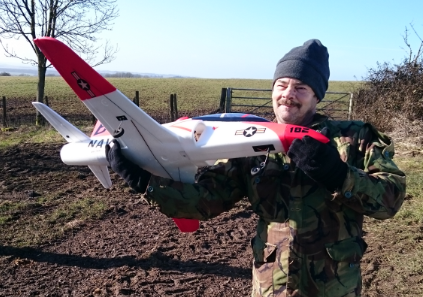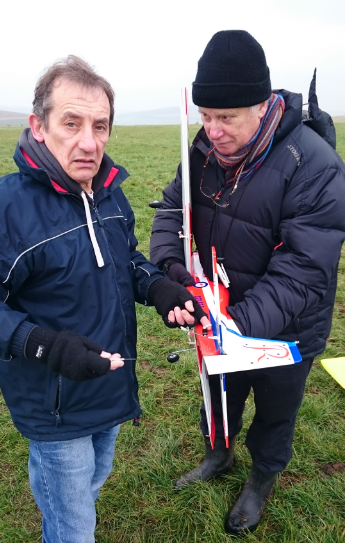Patch News – May 2015
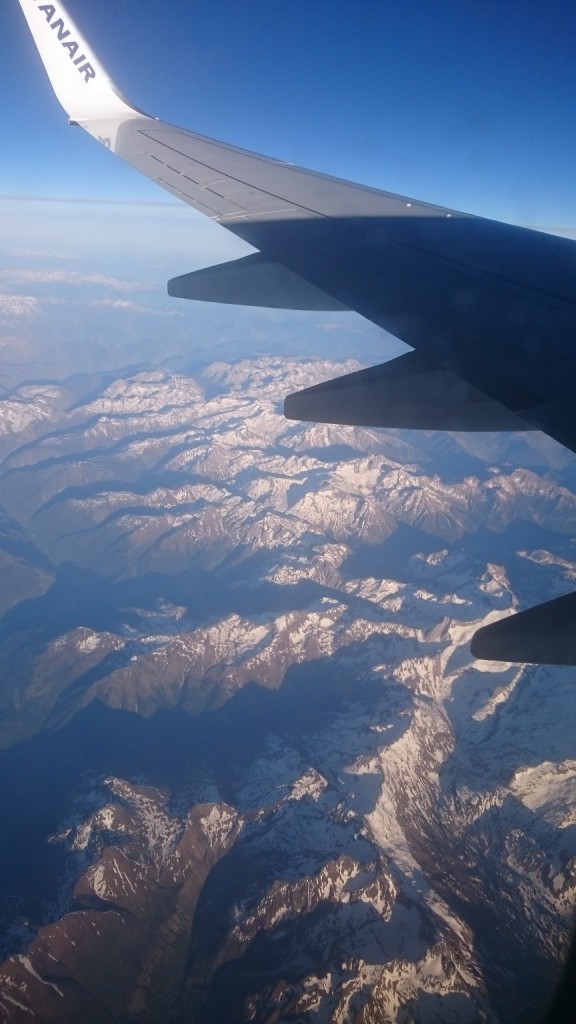 To start off, I must include a couple of things that I forgot in April. The first one wasn’t actually at the patch; it was before the start of one of our club meetings at Buriton. Steve 1066 decided that a bit of limbo between the goal posts was a good idea…it wasn’t, those steel goal posts are very hard!
To start off, I must include a couple of things that I forgot in April. The first one wasn’t actually at the patch; it was before the start of one of our club meetings at Buriton. Steve 1066 decided that a bit of limbo between the goal posts was a good idea…it wasn’t, those steel goal posts are very hard!
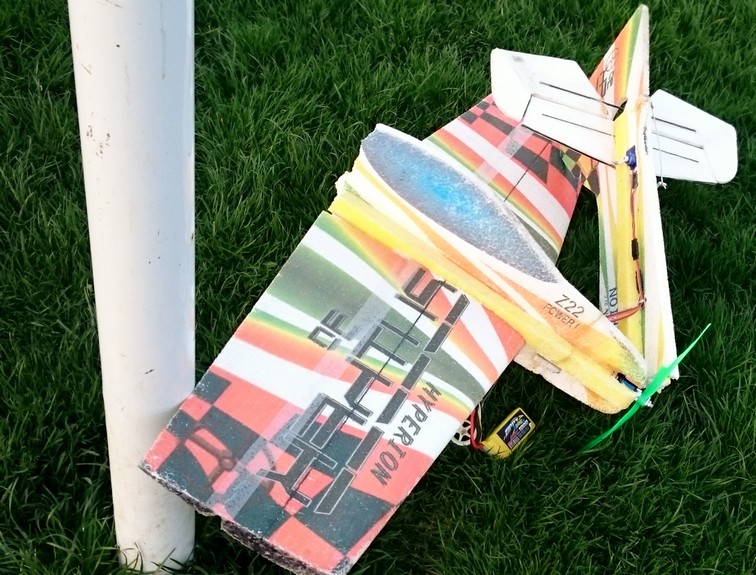
Secondly, I had forgotten to take a photo of Richard King after he had taken his ‘A’ test. Well here he is, looking suitably pleased with his achievement, well done Richard.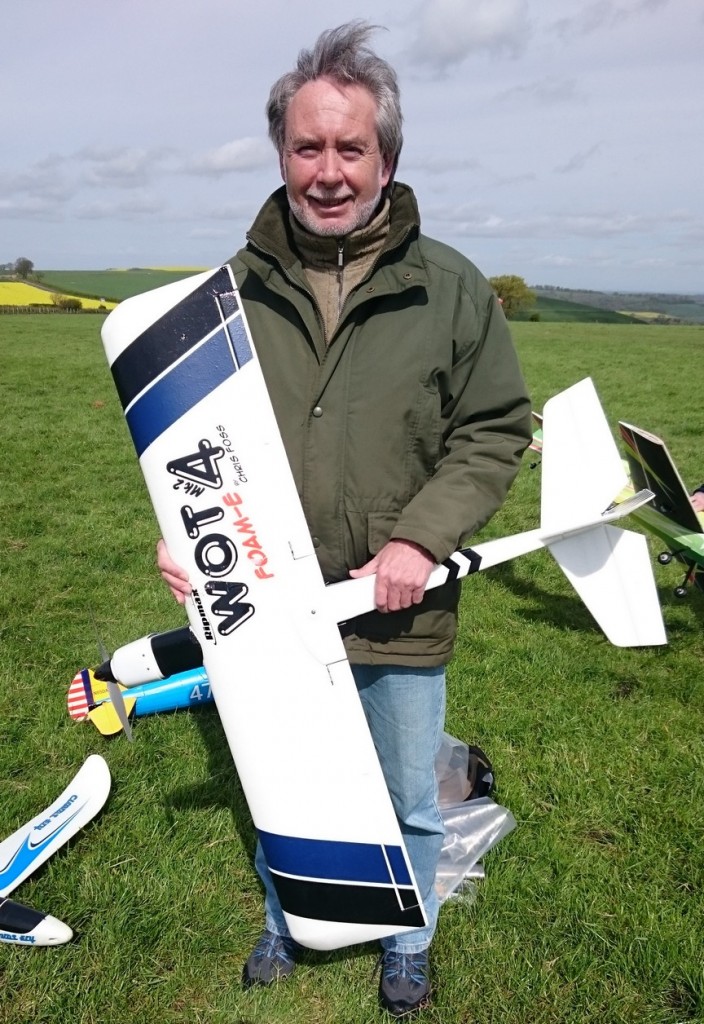 He doesn’t have a nickname yet, somehow Dick King doesn’t seem quite right…any ideas?
He doesn’t have a nickname yet, somehow Dick King doesn’t seem quite right…any ideas?
I must thank Richard for taking most of the video in this month’s video, everything before 1066 with his DLG was filmed by Richard, to watch it click on MONTHLY VIDEO and you’ll see Dougal’s Spitfire & Laius, Mike Smith’s Squall, Nigel Baker’s Wots Wot, Steve H’s Apollo DLG, and a couple of snippets from Blackbushe.
Last month I related the sorry tale of the first flight on newbie Tim Clay’s ST Discovery. If you remember it crashed before he even got to touch the transmitter, some sort of record I think! But now both the Discovery and Tim are flying really well, Tim has completed many flights totally by himself, including the take-offs and landings, with just the odd word of advice and guidance from whichever ‘expert’ has been with him. He managed a bit of a cartwheel on one landing which caused minor damage but that was soon sorted.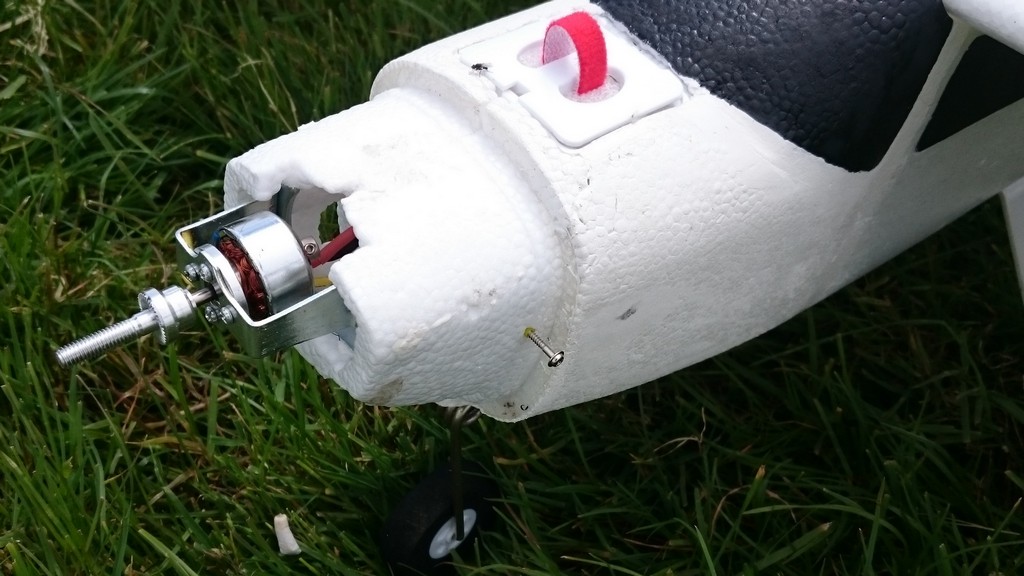 I’m sure Tim will be taking his ‘A’ test in the next couple of weeks.
I’m sure Tim will be taking his ‘A’ test in the next couple of weeks.
Tim has also been flying his second model, a HobbyKing Bixler 2.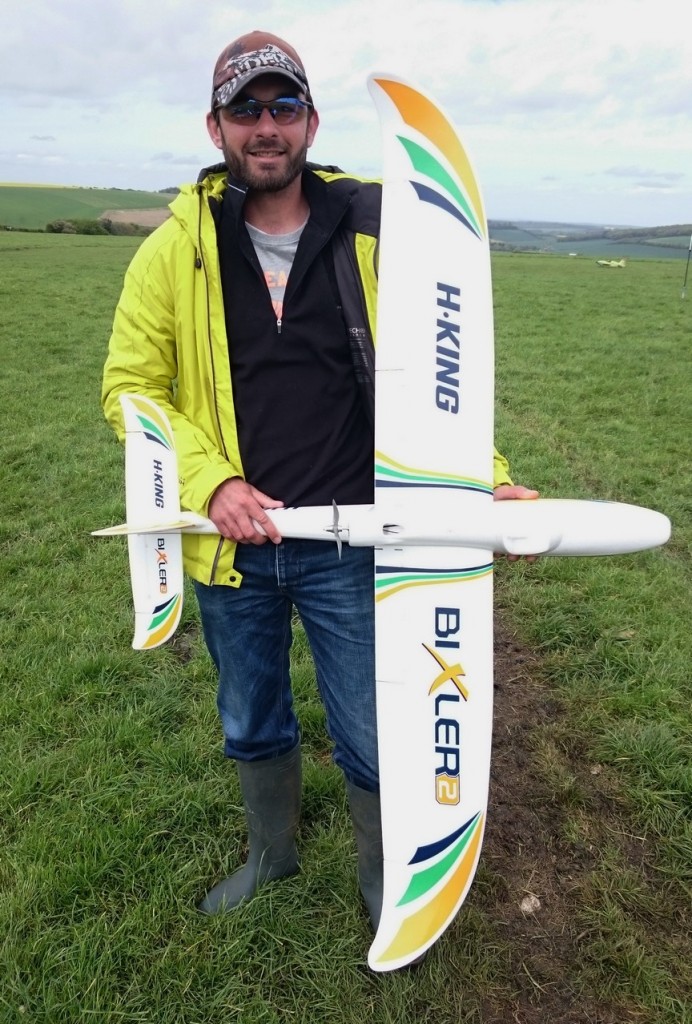 I have to say the Bixler seems an excellent model, flies really well, stable, but also aerobatic when required, I can see why they are so popular.
I have to say the Bixler seems an excellent model, flies really well, stable, but also aerobatic when required, I can see why they are so popular.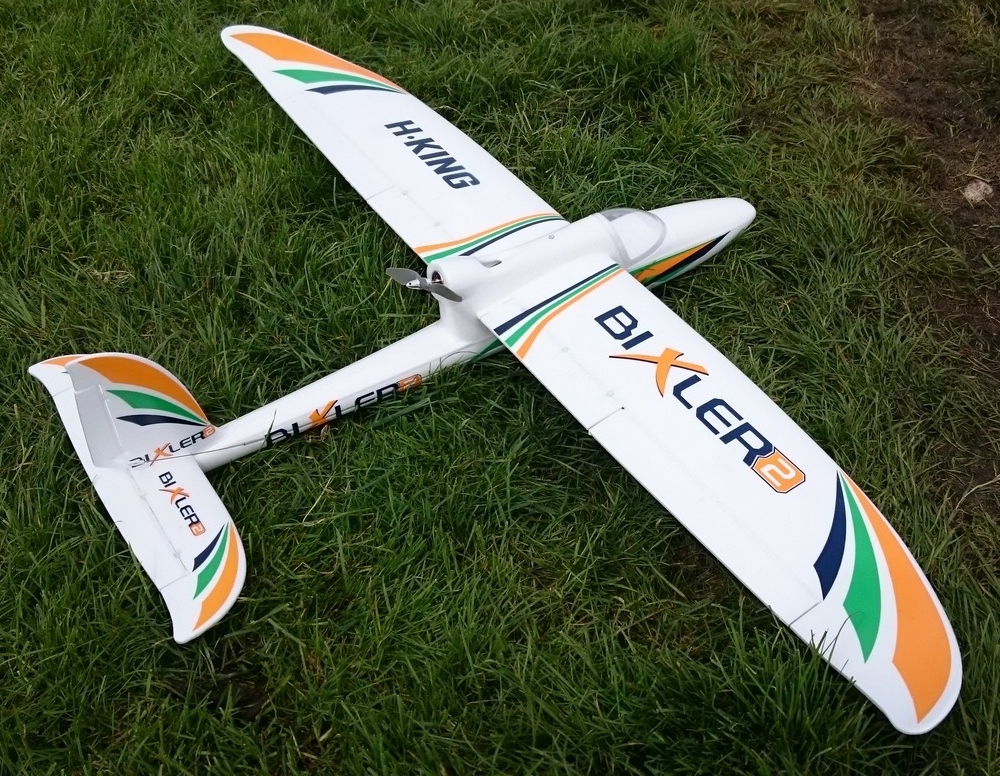
I mentioned Blackbushe earlier, this year it was on 16th May. I won’t say too much about it as I think DoughBoy (treasurer Nick Squire) is going to write a proper report with lots of quality photos.
Unlike last year (which became known as Crashbushe) there was no carnage, in fact I didn’t see a single crash all day. It seemed as if half the club was there to see some great flying, helped no doubt by the presence of Ali Machinchy, and some superb models.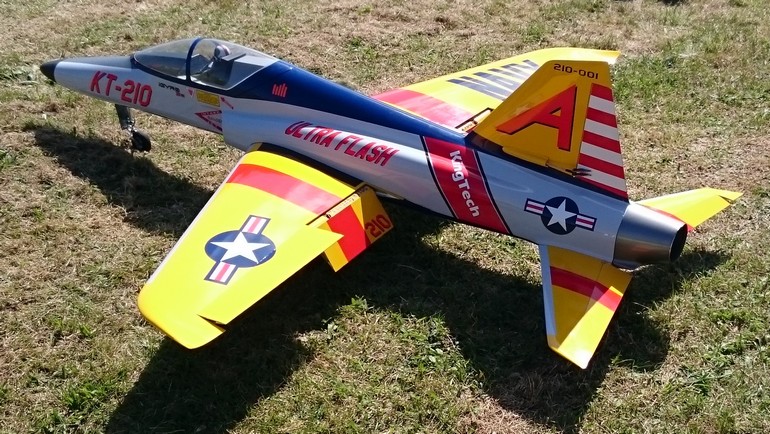 Viv (Stanley Knife) said he would like to have seen more ‘club’ style models such as Acro-Wots and such like and I think he has a point; virtually everything flying was a ‘show’ model rather than the sort of stuff we fly week in week out. And Chairman Ron pointed out that there weren’t many warbirds this year, although there was a Battle of Britain Memorial Flight trio of a Lanc, Spit, and Hurricane. There were loads of jets, turbines are becoming increasingly common these days, lower costs and simplicity of operation are big factors I imagine.
Viv (Stanley Knife) said he would like to have seen more ‘club’ style models such as Acro-Wots and such like and I think he has a point; virtually everything flying was a ‘show’ model rather than the sort of stuff we fly week in week out. And Chairman Ron pointed out that there weren’t many warbirds this year, although there was a Battle of Britain Memorial Flight trio of a Lanc, Spit, and Hurricane. There were loads of jets, turbines are becoming increasingly common these days, lower costs and simplicity of operation are big factors I imagine.
This year the show was opened by Steve Holland flying a 66% scale, 4 metre span Aerokot, the full-size itself being a home-built modelled on a Bucker Jungmeister.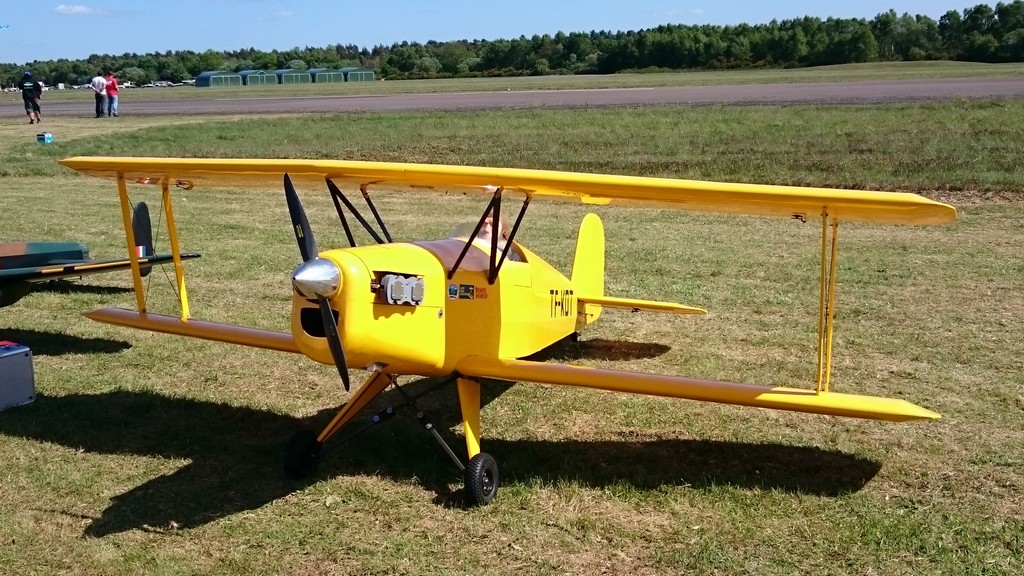 It is powered by a DA150 petrol engine and Steve used his expertise to show it off very well I thought.
It is powered by a DA150 petrol engine and Steve used his expertise to show it off very well I thought.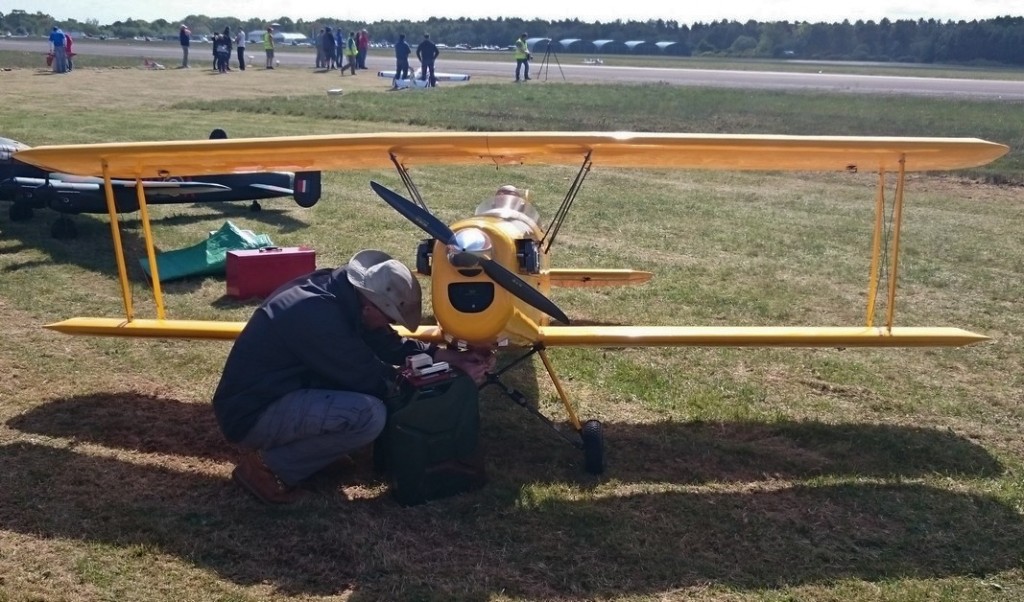 But I wouldn’t want to pay the fuel bill!
But I wouldn’t want to pay the fuel bill!
The Bishops father and son team were flying new models this year, Krill Avanti S’s with Jet Italia turbines.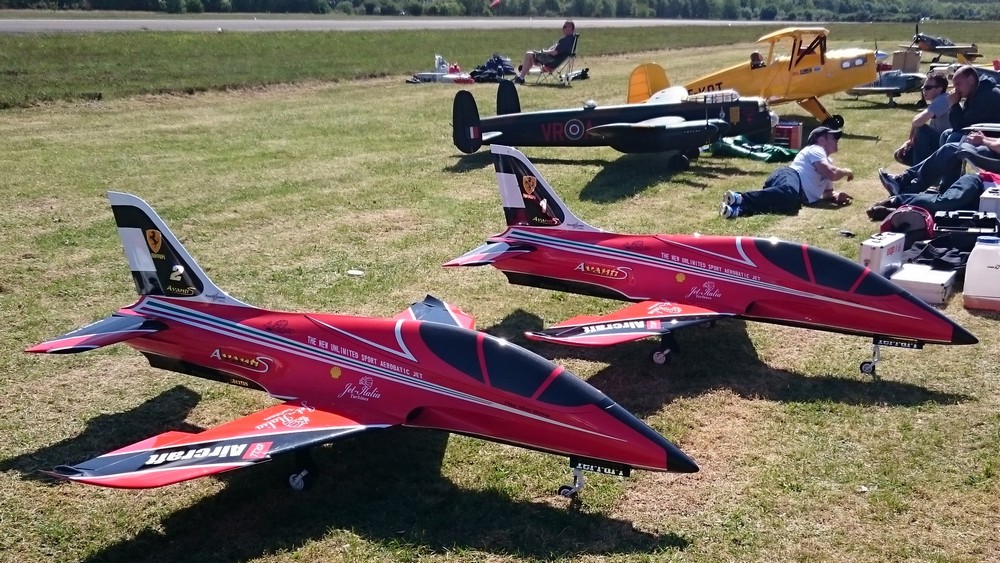 They hadn’t flown the models together before Blackbushe and understandably they weren’t as good in formation as we are used to seeing with their Red Arrows Hawks but by their third flight of the day there was a noticeable improvement.
They hadn’t flown the models together before Blackbushe and understandably they weren’t as good in formation as we are used to seeing with their Red Arrows Hawks but by their third flight of the day there was a noticeable improvement.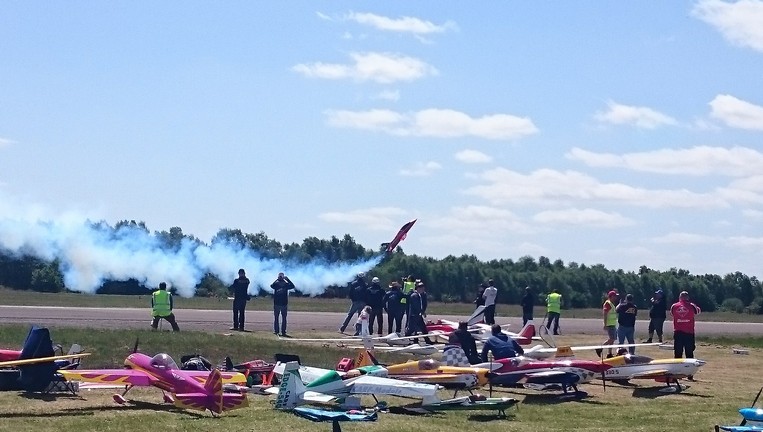 But what made them stand out was the thrust vectoring fitted to the models which enabled them to prop hang (?), amazing to watch, especially when they turned the smoke on!
But what made them stand out was the thrust vectoring fitted to the models which enabled them to prop hang (?), amazing to watch, especially when they turned the smoke on!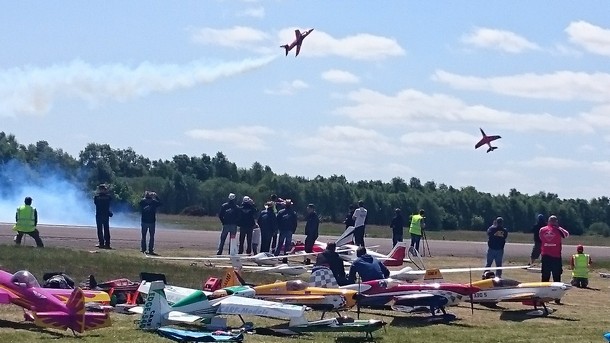
There was another jet duo; Simon Potter and Paul Camilleri, flying 2.5 metre span Tomahawk Futura jets.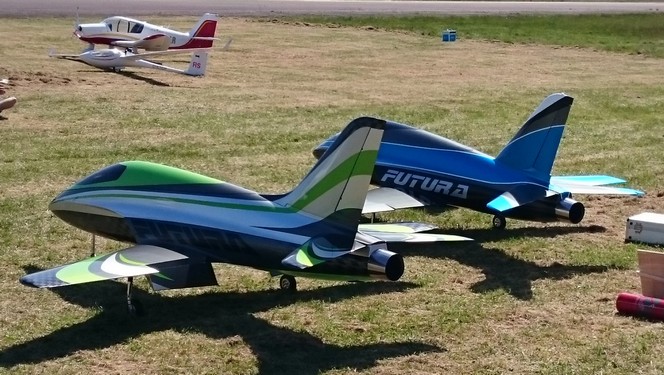 They were also very good, one of them doing a pass so low I don’t think there would have been room to lower the wheels…seriously!
They were also very good, one of them doing a pass so low I don’t think there would have been room to lower the wheels…seriously!
When the commentator said that Ali was flying with Spektrum radio in his jet DoughBoy and 1066 laughed but Tim fell to his knees in prayer!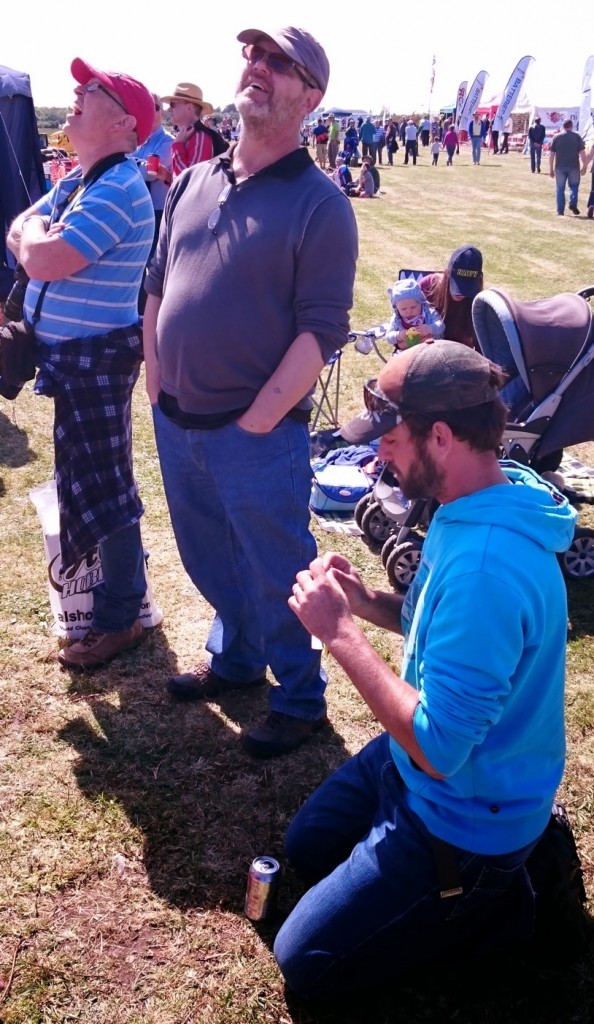
Fortunately there weren’t many helicopter slots, something for which us fixed wing pilots were grateful, they are just boring to us I’m afraid, a real yawn.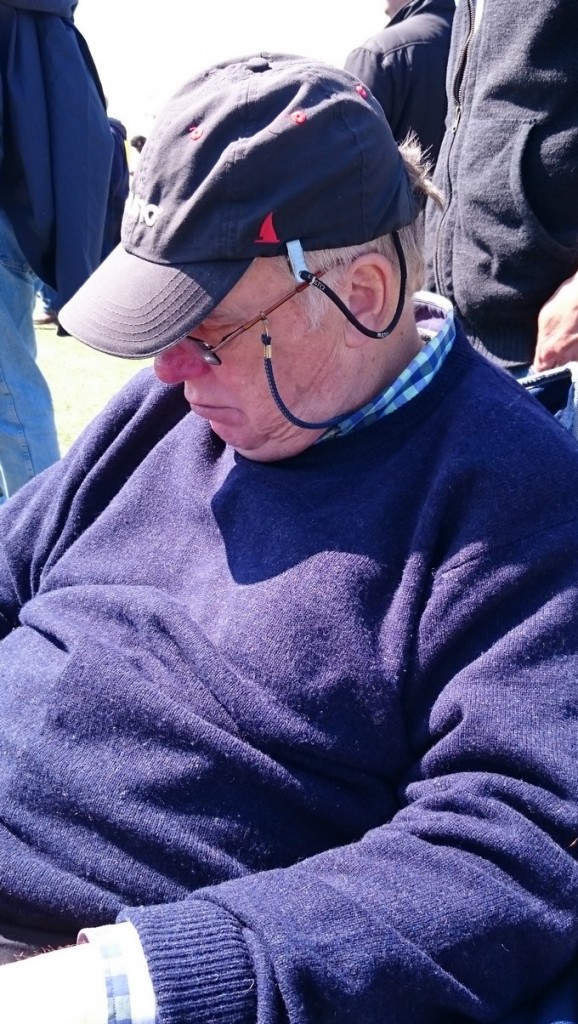 Gentleman Jim obviously thought so anyway!
Gentleman Jim obviously thought so anyway!
Captain Altitude (Woody) splashed his cash on a new Spektrum DX6 to replace his DX6i that is playing up. He’s pictured here testing it out at our field the next day.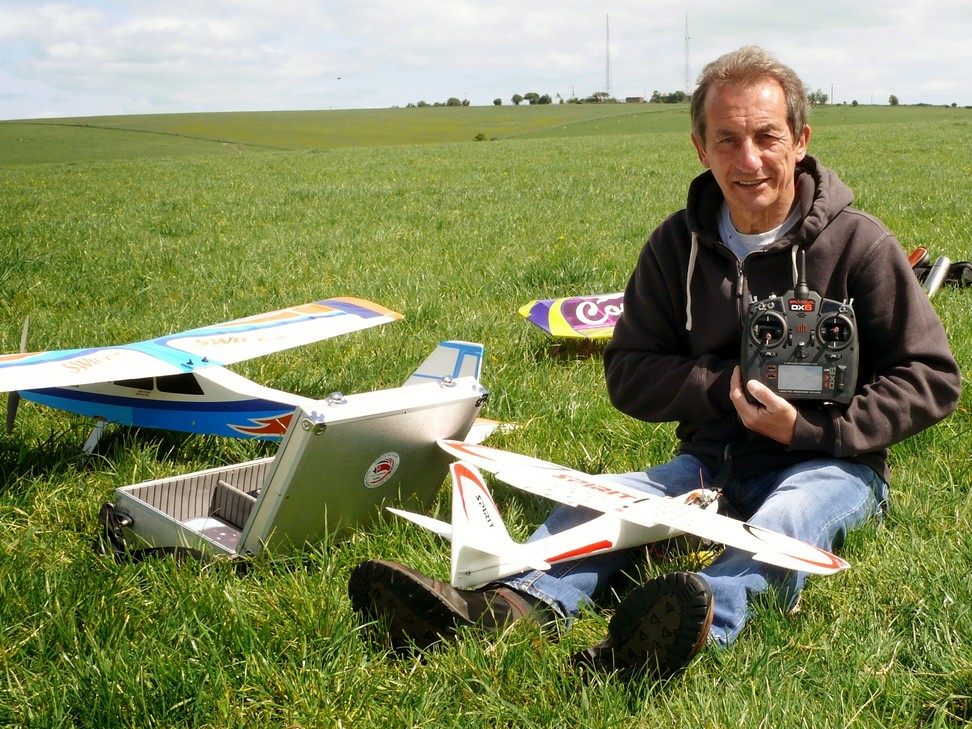
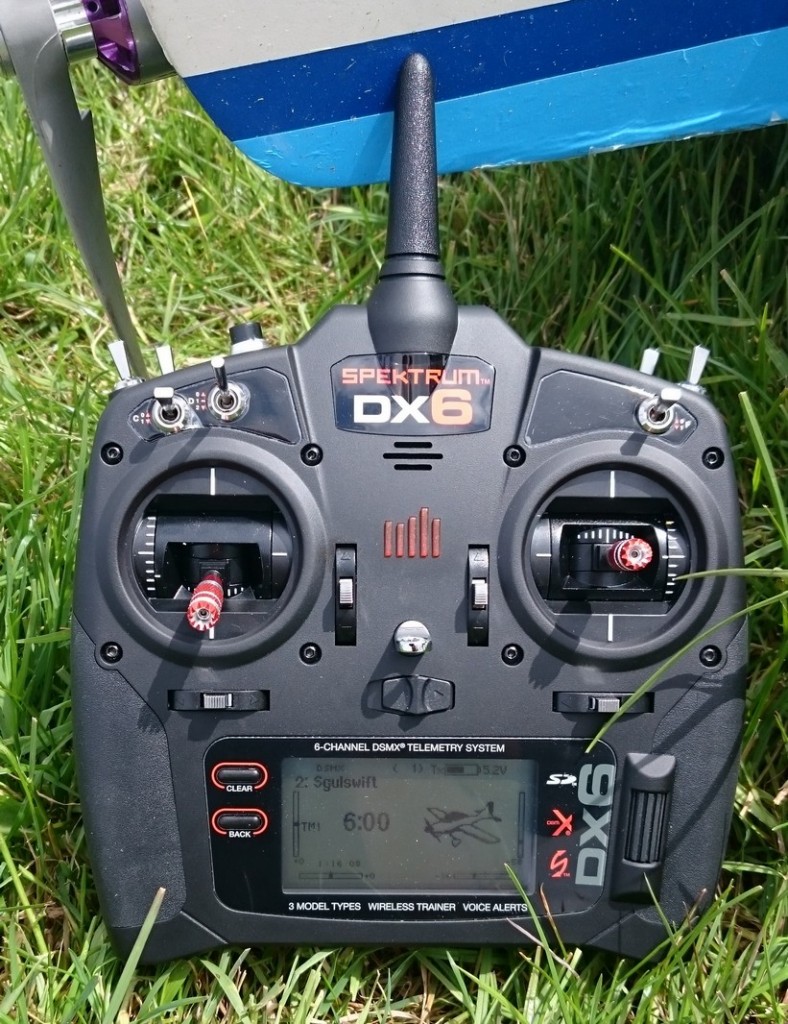 Smiffy bought a Blade helicopter to play with in his garden and then realised that it was Bind’n’Fly so his Hitec transmitter wouldn’t bind to it. A normal person would have simply fitted the chopper with a Hitec receiver but not Smiffy; he bought a Spektrum DX6 transmitter instead.
Smiffy bought a Blade helicopter to play with in his garden and then realised that it was Bind’n’Fly so his Hitec transmitter wouldn’t bind to it. A normal person would have simply fitted the chopper with a Hitec receiver but not Smiffy; he bought a Spektrum DX6 transmitter instead.
There weren’t too many new models seen at the patch this month but Stanley Knife turned up with this lovely new Spacewalker.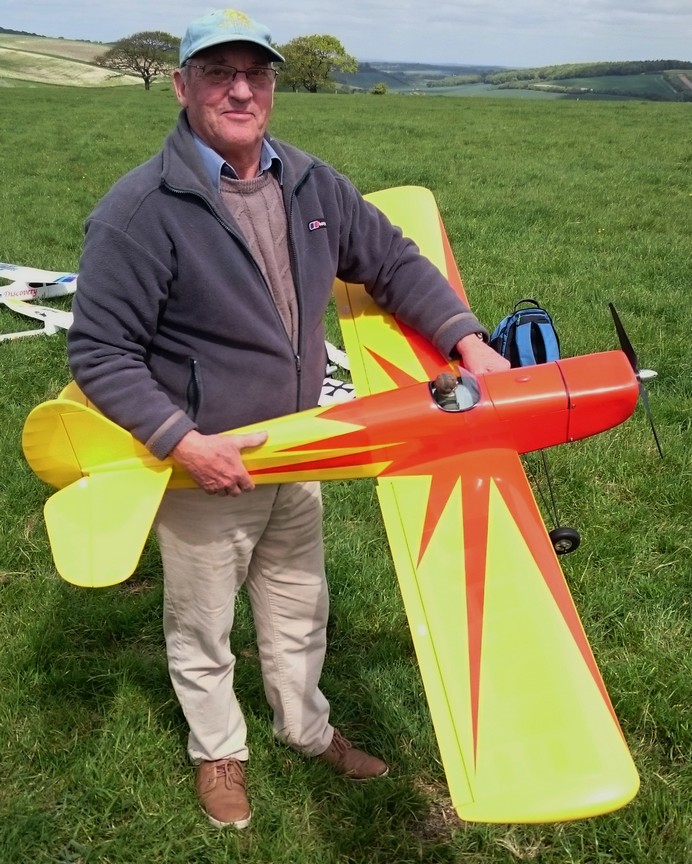 It’s from HobbyKing and at 1580mm span it’s designed to be either I/C or electric powered. Stanley chose the electric route of course and obviously got the motor/battery choice just right as the model flies beautifully.
It’s from HobbyKing and at 1580mm span it’s designed to be either I/C or electric powered. Stanley chose the electric route of course and obviously got the motor/battery choice just right as the model flies beautifully.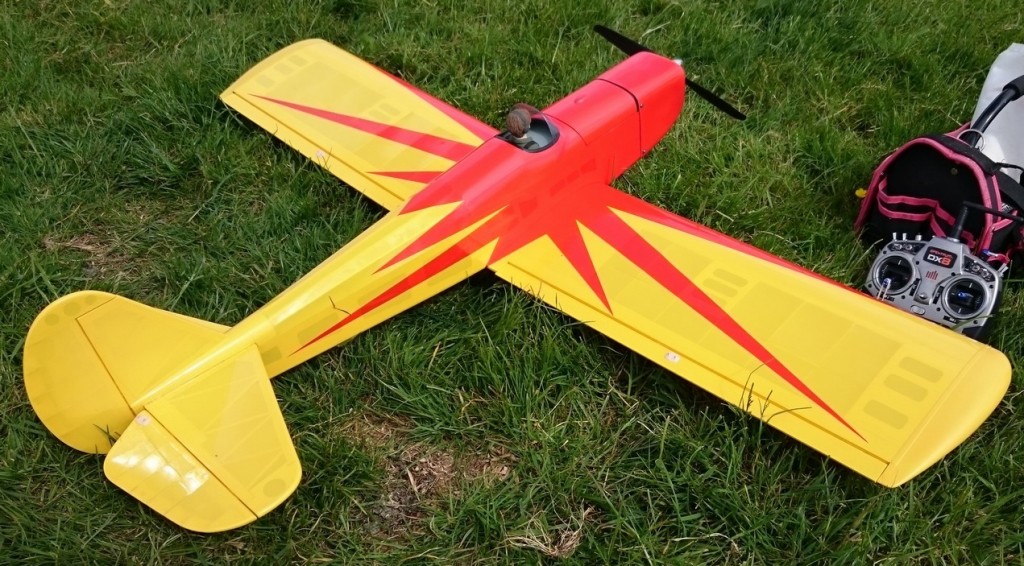 It’s a ‘proper’ film covered balsa and ply model with a GRP cowl, not a foamie.
It’s a ‘proper’ film covered balsa and ply model with a GRP cowl, not a foamie.
In traditional manner Nigel Baker managed to remove the Almost Ready To Fail undercarriage from the new fuselage of his Wot 4 Foam-E. It’s nothing that a decent ply plate won’t sort out.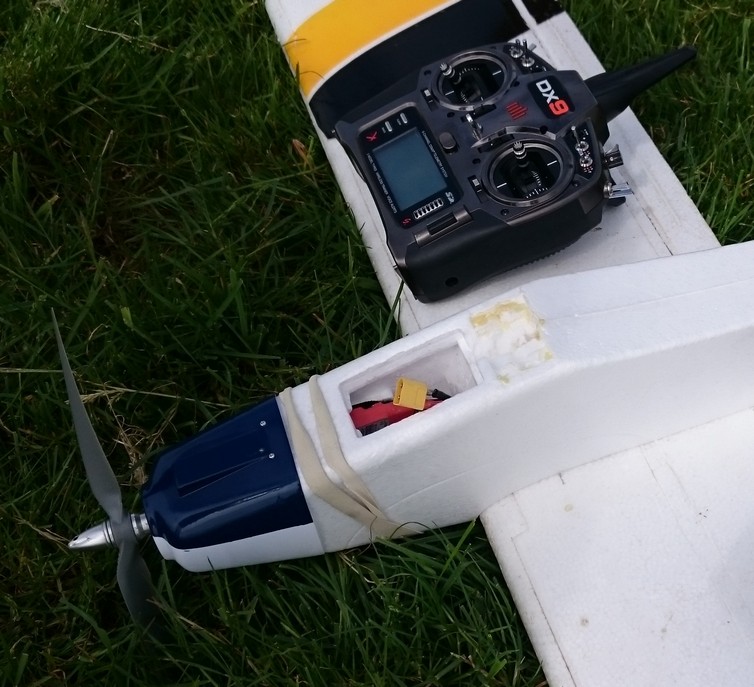
You can tell that summer is on its way, several models that we haven’t seen over the winter made re-appearances. Mike Smith flew his Phase 3 Squall again in May, the first time for a few months.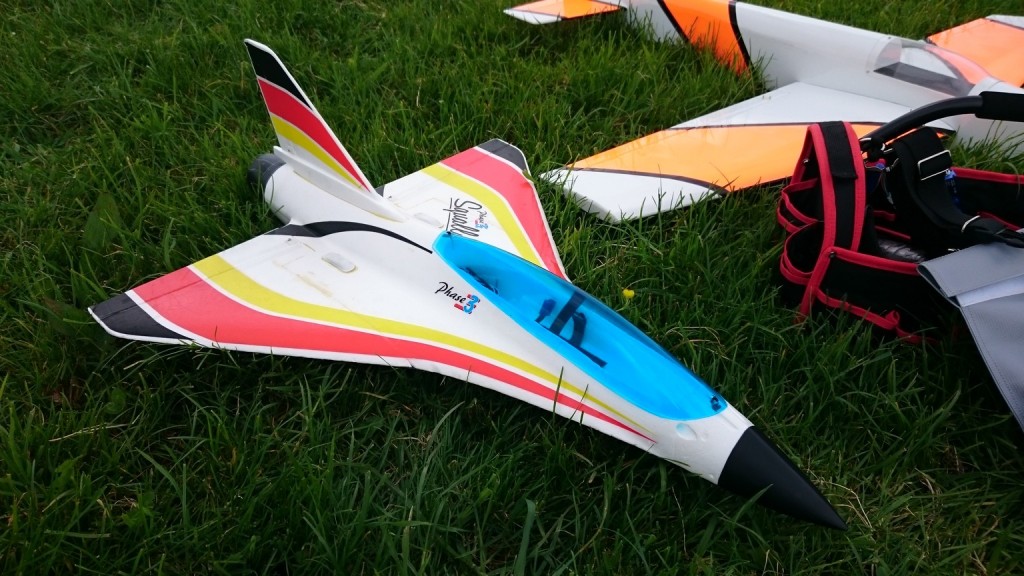 It’s EDF and I’d forgotten how quick it goes, and it rolls like an electric drill. It features in this MONTHLY VIDEO
It’s EDF and I’d forgotten how quick it goes, and it rolls like an electric drill. It features in this MONTHLY VIDEO
Dan Handley flew his Dynam Hurricane for the first time in a while.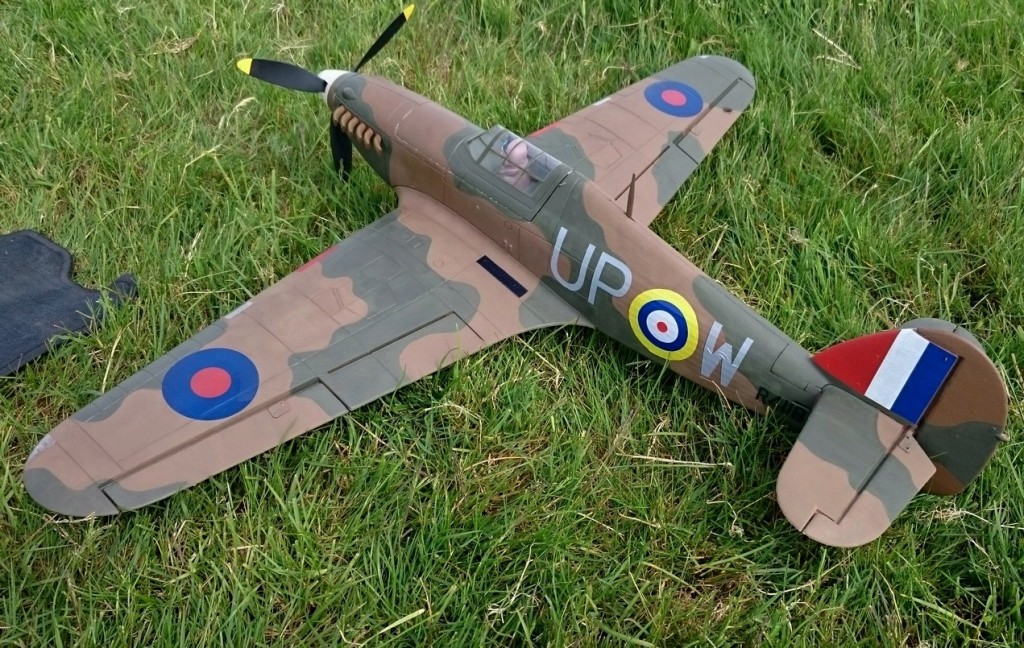 It’s 1250mm span, uses a 4 cell lipo to drive a 600kv motor, and comes fitted with worm drive retracts.
It’s 1250mm span, uses a 4 cell lipo to drive a 600kv motor, and comes fitted with worm drive retracts.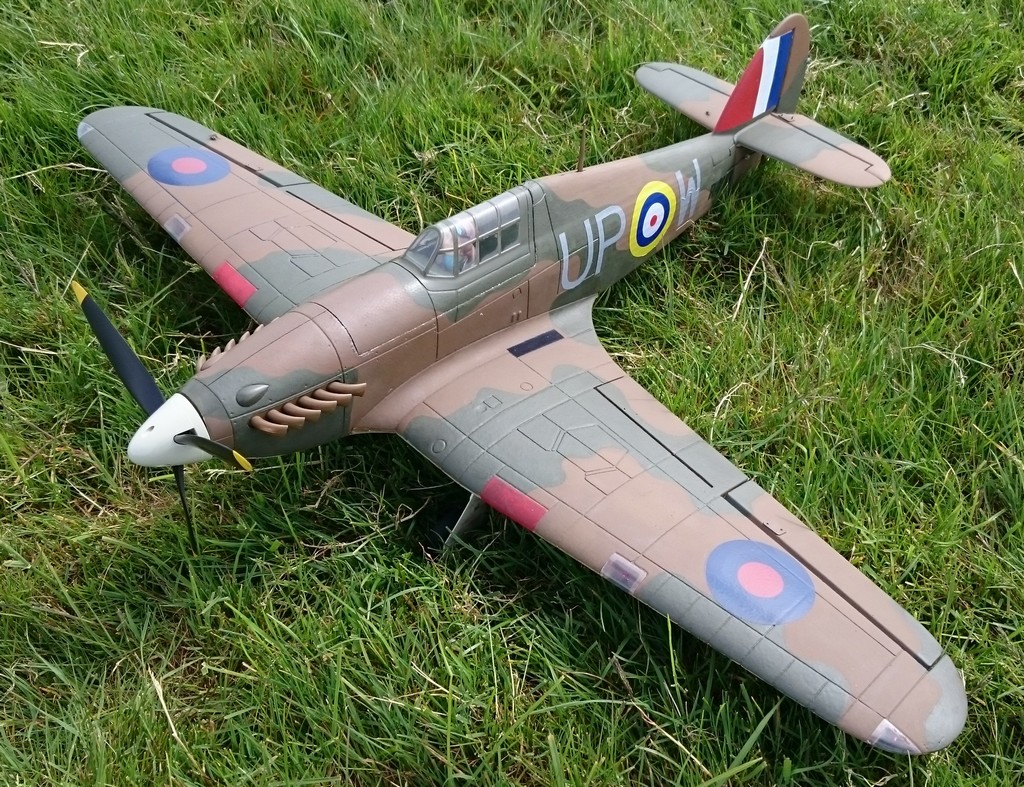 It’s a foamie but it looks great and flies very well.
It’s a foamie but it looks great and flies very well.
The rather battled scarred SE5a belonging to Bob Hill also flew again this month.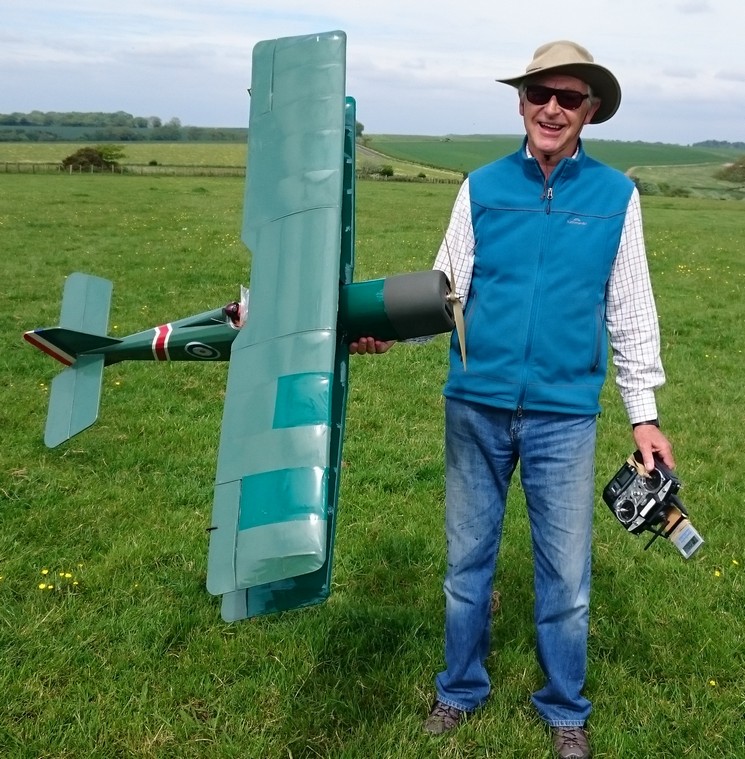 It flies well but isn’t a model you’d want to fly in the winds of winter, especially the winds we get on top of Chidden Down.
It flies well but isn’t a model you’d want to fly in the winds of winter, especially the winds we get on top of Chidden Down.
The Spirit Mini Sport gliders continue to thrive and Tony Neal has now joined the throng, although he has gone for a Kinetic instead of a Spirit. The two models are virtually identical although they are fitted with different motors. A few Spirit motors have failed (including my own) and HobbyKing don’t stock replacements so the easy choice is to fit a Kinetic motor instead. They aren’t a direct swap but are pretty easy to fit, although it is necessary to use a Kinetic prop as well.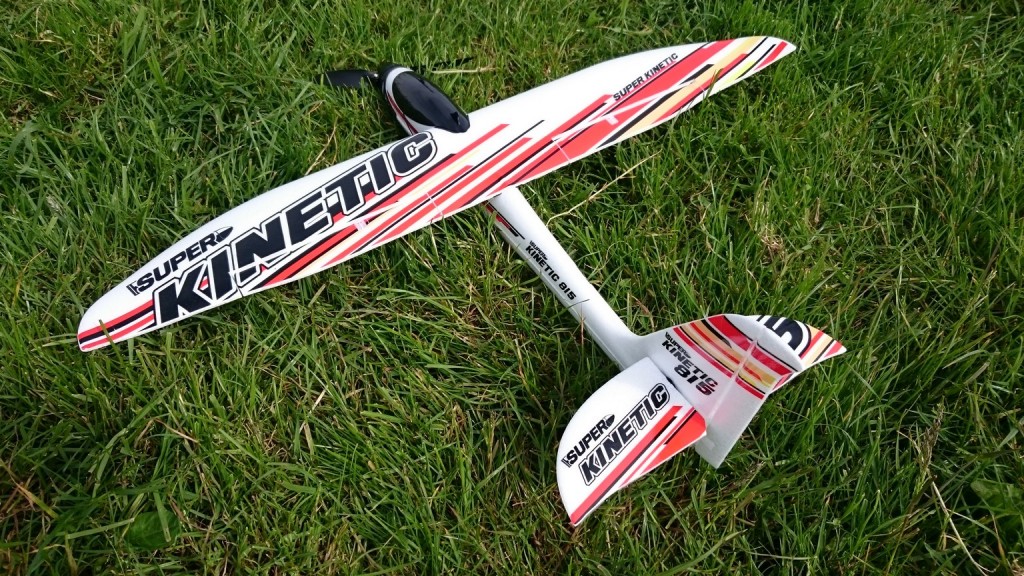 Bob Hill has also gone the Kinetic route; I think he managed to destroy his Spirit in a less than perfect ‘arrival’. I have only just discovered that the Kinetic comes with the decals already applied. As applying the decals is the biggest job required to complete the Spirit I reckon the Kinetic is the way to go.
Bob Hill has also gone the Kinetic route; I think he managed to destroy his Spirit in a less than perfect ‘arrival’. I have only just discovered that the Kinetic comes with the decals already applied. As applying the decals is the biggest job required to complete the Spirit I reckon the Kinetic is the way to go.
As I’m talking about the Spirits I’ll include a photo that Dougal Entendre sent me a little while ago. His elevator servo needed replacing so he had to remove the servo cover that is factory fitted. He says it was easy to prise off and he managed to replace the servo and refit the cover without problems.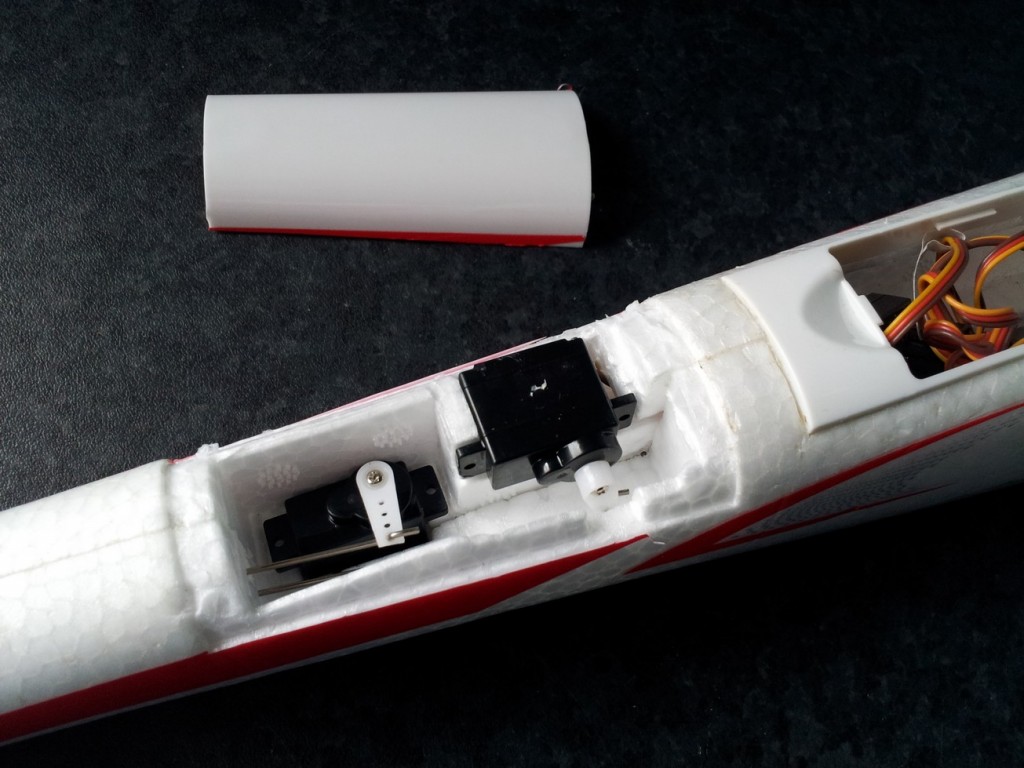 I was surprised by the servo layout; I had assumed both the servos would be fitted upright, not with one laying on its side.
I was surprised by the servo layout; I had assumed both the servos would be fitted upright, not with one laying on its side.
I took the plunge in the HobbyKing May Day sale and ordered a Hummer. It’s one of those horribly ugly 3D EPP profile fuselage things made from packing cases but it does what it’s supposed to do. It was only £16 odd so I thought I should at least try 3D to find out what the appeal is. So far I haven’t found out!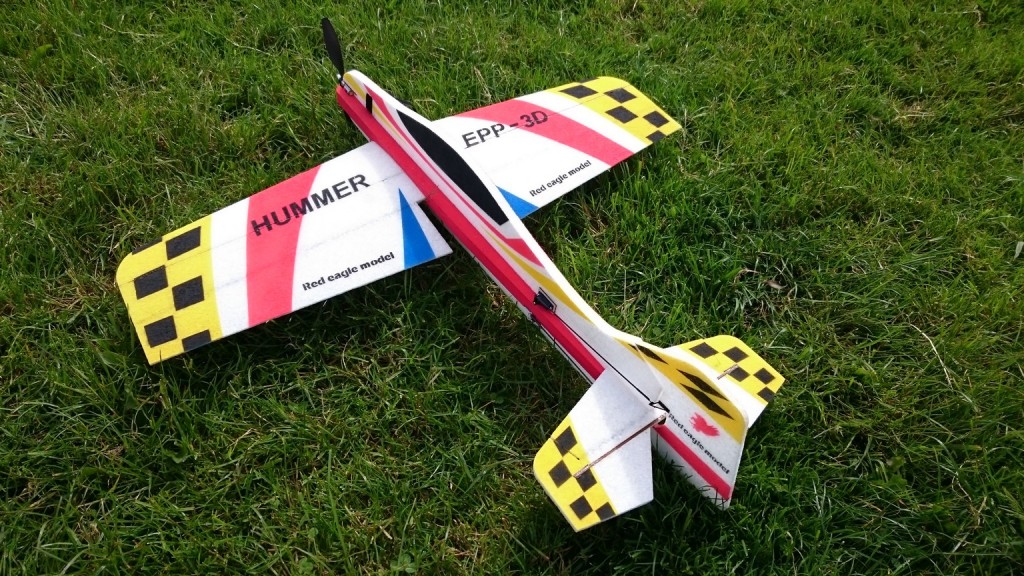 That’s probably because mostly I’ve found out that I can’t do it but I’ve only had a few flight so I’ll keep at it and see what happens. The ‘kit’ was pretty good, everything fitted ok, and the carbon rods alone would have cost more than the whole kit at most models shops. I used cyano for virtually the whole of the construction, time will tell whether that was wise or just lazy.
That’s probably because mostly I’ve found out that I can’t do it but I’ve only had a few flight so I’ll keep at it and see what happens. The ‘kit’ was pretty good, everything fitted ok, and the carbon rods alone would have cost more than the whole kit at most models shops. I used cyano for virtually the whole of the construction, time will tell whether that was wise or just lazy.
Unbeknown to me Dougal was putting one together at the same time so now there are two of us trying to learn how to prop hang. We could be the next Bishops…or not.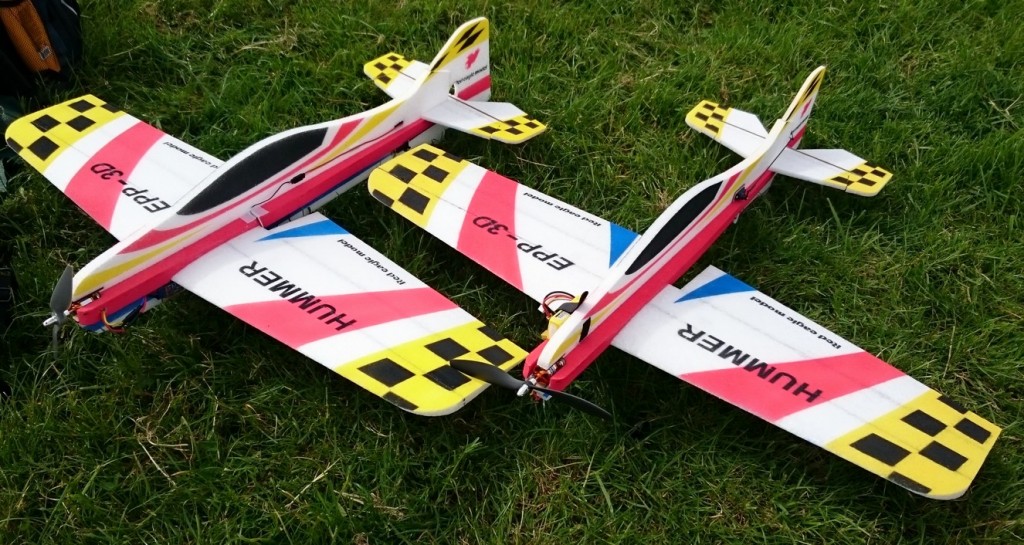
The last new model we saw in May was 1066’s Apollo DLG. This is yet another from HobbyKing, and has a fibreglass fuselage pod and tail boom, with pre covered balsa and ply built up wings and tail.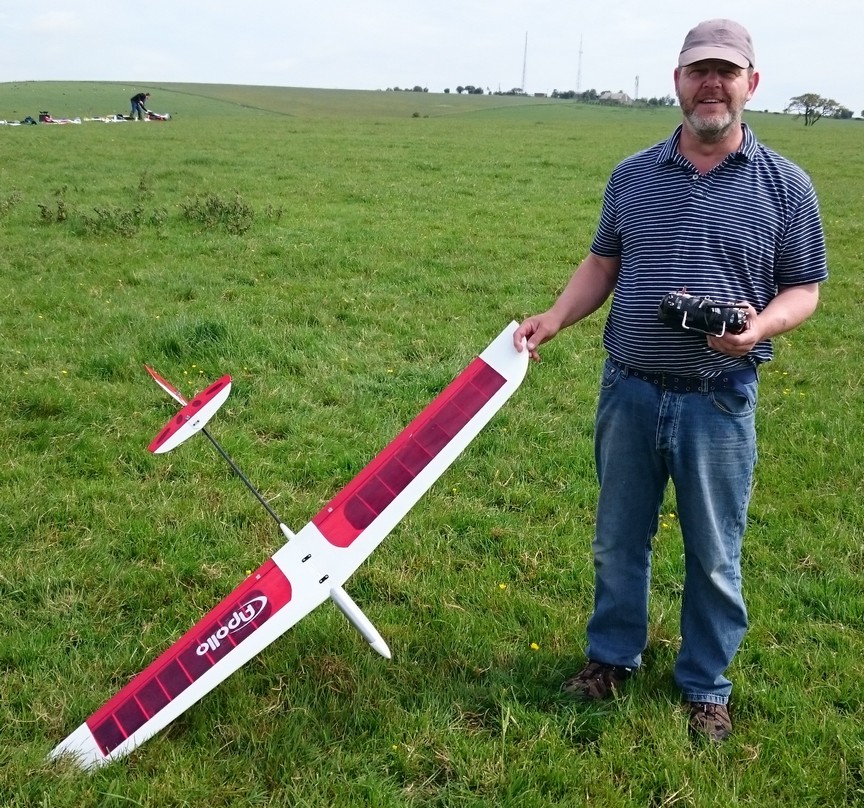 The HK listing mentions composite so I think it must have carbon in the spar. A full composite DLG model costs a lot of money, this one is under £50. For those who don’t know, DLG stands for Discus Launch Glider, and that’s just how they are launched. There is a peg mounted vertically through the wingtip that the pilot hooks his fingers round, he then spins round a complete turn and releases the model into wind. Once the technique is mastered the models can reach amazing height and, being very lightly built, they can stay aloft for a considerable time, searching out the weakest of thermals. It’s a highly skilled class of modelling, and it will be interesting to see how Steve gets on with it once he’s mastered the launch and trimmed the model correctly. See it in action in the MONTHLY VIDEO
The HK listing mentions composite so I think it must have carbon in the spar. A full composite DLG model costs a lot of money, this one is under £50. For those who don’t know, DLG stands for Discus Launch Glider, and that’s just how they are launched. There is a peg mounted vertically through the wingtip that the pilot hooks his fingers round, he then spins round a complete turn and releases the model into wind. Once the technique is mastered the models can reach amazing height and, being very lightly built, they can stay aloft for a considerable time, searching out the weakest of thermals. It’s a highly skilled class of modelling, and it will be interesting to see how Steve gets on with it once he’s mastered the launch and trimmed the model correctly. See it in action in the MONTHLY VIDEO
Meanwhile 1066 has been showing off his knife-edging skills with his Extra 300. This one is an ex-Cyano Steve model, produced by 3D Hobby Shop.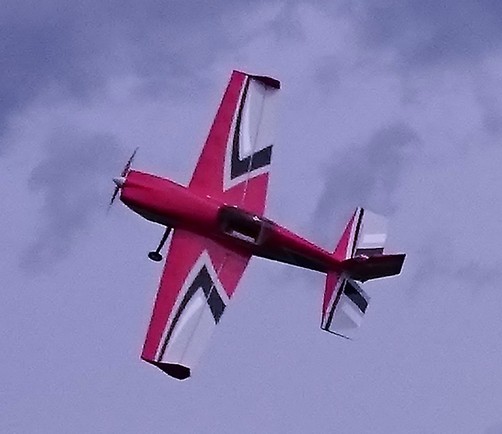
Captain Slow was good enough to send me a link to an airline Safety Announcement, it’s very funny and well worth watching, you can see it by clicking: HERE
STOP PRESS: Tim Clay took and passed his BMFA ‘A’ certificate this morning. Well done Tim, you’ve reached this stage very quickly, some of the more experienced pilots are watching you with envy!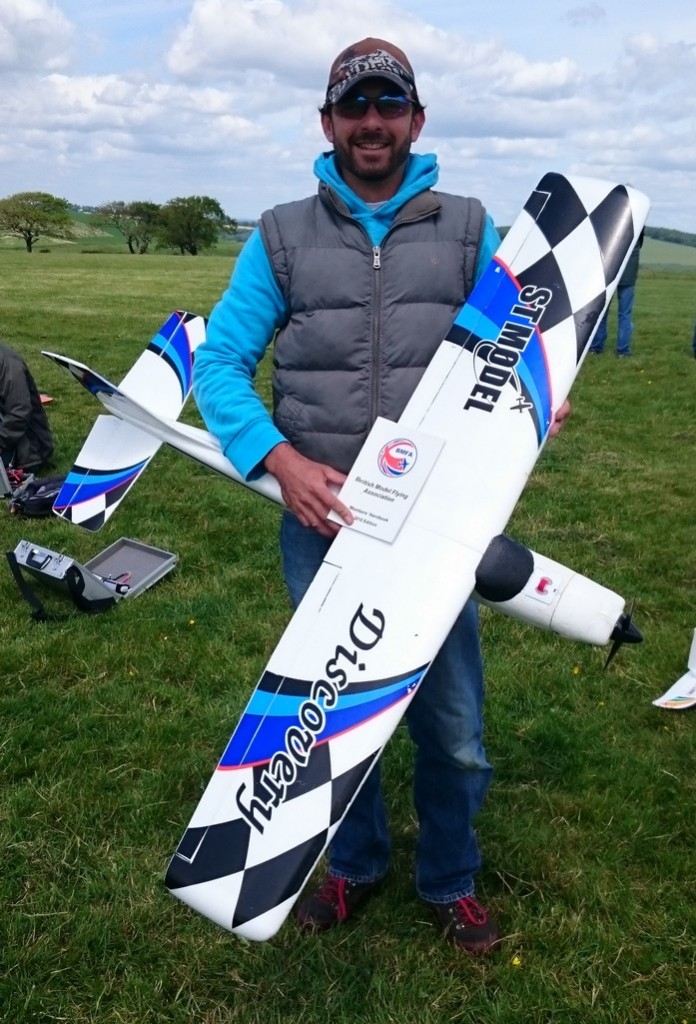
Remember: You do not need a parachute to skydive. You only need a parachute to skydive twice.
Colin Cowplain
Patch News – April 2015
April saw the weather improve dramatically and for a couple of weeks after Easter it was perfect for flying. The Midweekers made good use of the weather and flew lots. Chairman Ron cut the grass a few times and the patch was looking great…until the sheep and cows arrived. Never mind, I expect they’ll soon be gone. Of course there were some bad days as well, the last Sunday in April was very grey with low mist/cloud and although we flew it wasn’t ideal. However the following day was absolutely glorious and I took this photo so the people who were back at work won’t feel too left out, obviously we felt for them!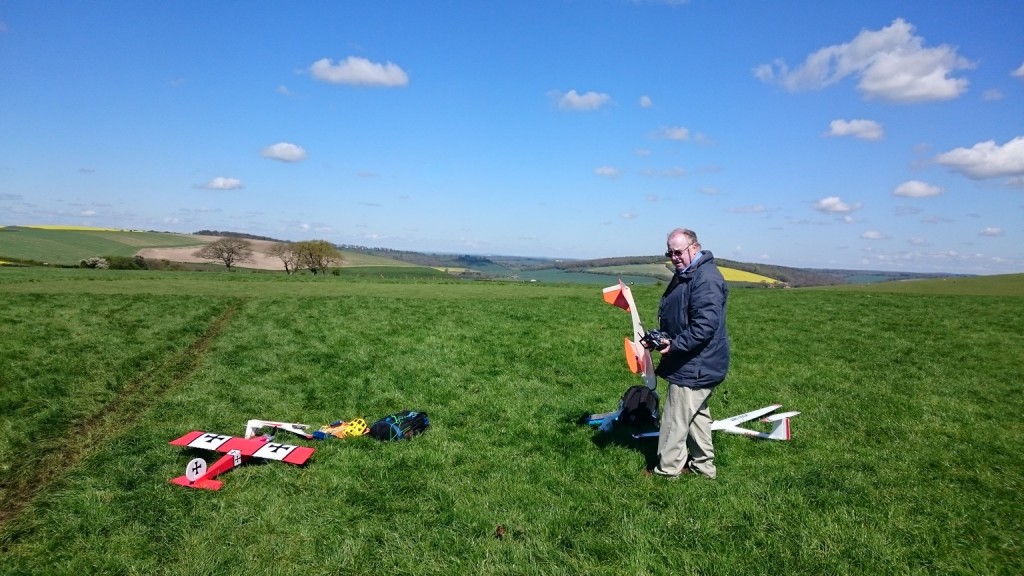
I’ll start this month with a link that has absolutely nothing to do with the patch or even the club but it’s sort of aviation and it’s just so good you all need to see it, trust me, you will like it! CLICK HERE
We had a new arrival in April, Tim Clay. He is new to flying but his dad is a long term modeller and Chairman of Eastbourne & District Model Flying Club so Tim has grown up with modelling. He’s spent some time on a simulator and it shows. Tim had obviously taken advice from dad and he turned up with an ST Discovery, an ideal electric powered trainer, and he was equipped with two transmitters and a buddy lead.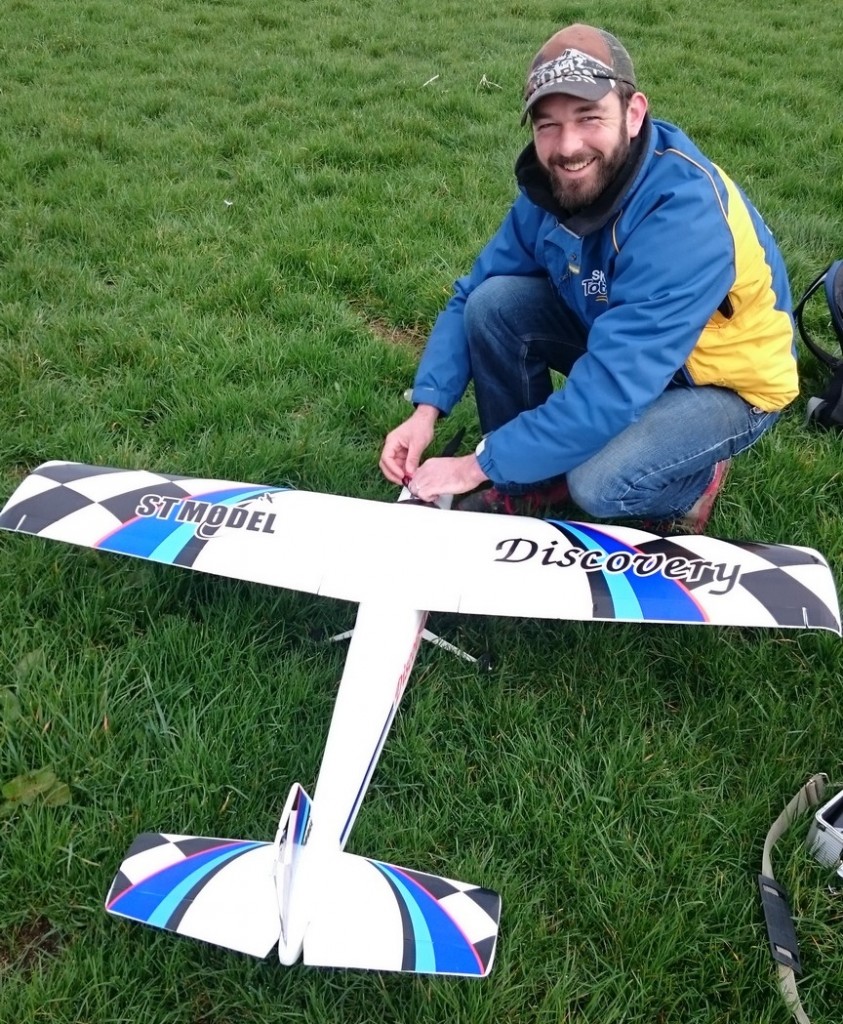 Unfortunately we didn’t get off to a good start. Steve 1066 checked it all over and trimmed the model out on the master TX, did a couple of rolls etc. , then passed control to me on the slave TX. I trimmed it out and then did a roll but when I stopped the roll the plane carried on. Steve released the buddy switch to take back control but the plane just kept rolling all the way into the deck.
Unfortunately we didn’t get off to a good start. Steve 1066 checked it all over and trimmed the model out on the master TX, did a couple of rolls etc. , then passed control to me on the slave TX. I trimmed it out and then did a roll but when I stopped the roll the plane carried on. Steve released the buddy switch to take back control but the plane just kept rolling all the way into the deck.
Hang on; I think I might have spotted a problem with the slave TX…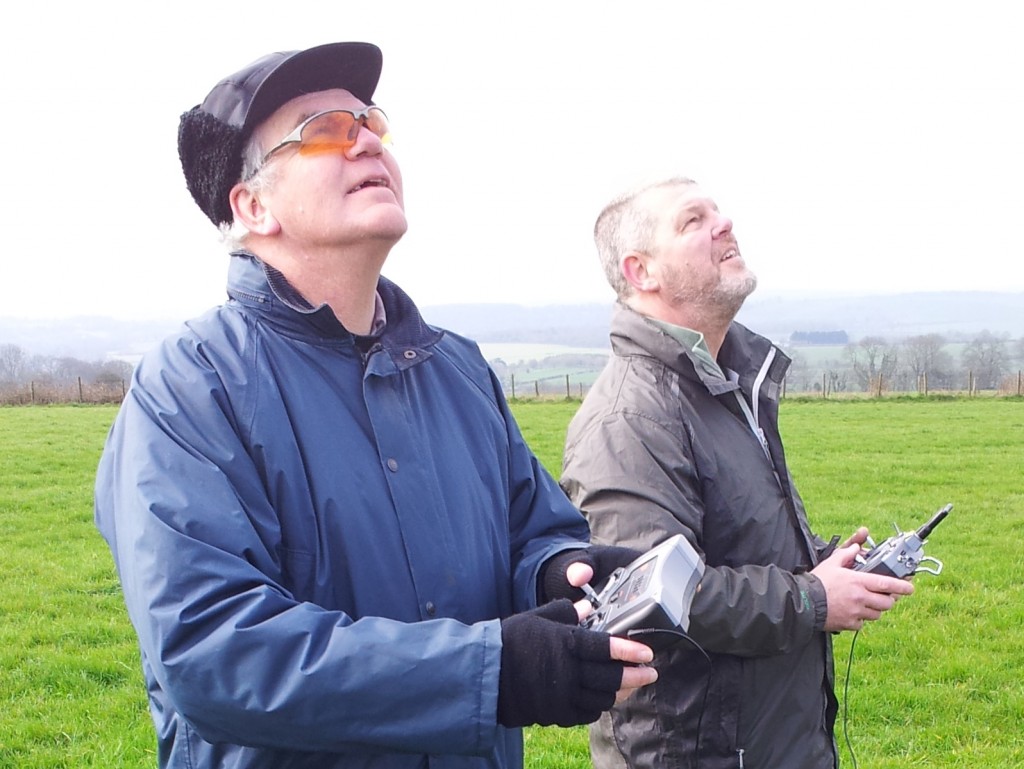 Fortunately the damage wasn’t too bad but it certainly wasn’t what should have happened. The plane has been repaired and has now had several flights (without using the buddy lead) with no further problems.
Fortunately the damage wasn’t too bad but it certainly wasn’t what should have happened. The plane has been repaired and has now had several flights (without using the buddy lead) with no further problems.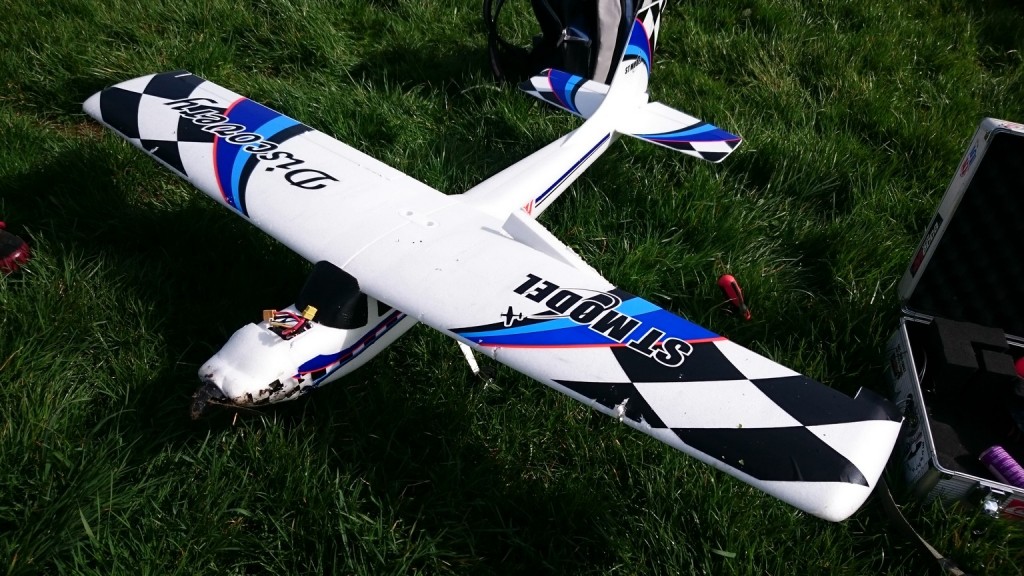 Both Steve and I have since taken Tim for flights with the Discovery so hopefully he knows we are aren’t really a pair of idiots. We don’t know for sure what the problem was but we think the radio went into failsafe mode and it was possibly something related to the buddy lead. Guess what make the radio is… no I mustn’t! Following the crash Richard King kindly let Tim have several flights with his Clouds Fly and it was immediately clear that Tim won’t take long to learn how to fly.
Both Steve and I have since taken Tim for flights with the Discovery so hopefully he knows we are aren’t really a pair of idiots. We don’t know for sure what the problem was but we think the radio went into failsafe mode and it was possibly something related to the buddy lead. Guess what make the radio is… no I mustn’t! Following the crash Richard King kindly let Tim have several flights with his Clouds Fly and it was immediately clear that Tim won’t take long to learn how to fly.
Richard King’s flying has been steadily improving, flying both his Clouds Fly and Wot 4 Foam-E, and most of his training has been undertaken with Dougal Entendre (Mark Agate) supervising. As Dougal is now a club examiner it seemed fitting that he should take Richard for his ‘A’ test. Richard was certainly ready for the test and seemed determined to prove it by taking the test on a day when there was a howling gale blowing. All went well, Richard certainly showed he can fly a Wot 4 in pretty much any weather, and he passed the test and received his certificate at the following club meeting. Well done Richard.
Sadly I forgot to take a photo of Richard, in fact looking back through my pictures I don’t think I’ve ever taken a one of him, although I have found one of his Clouds Fly.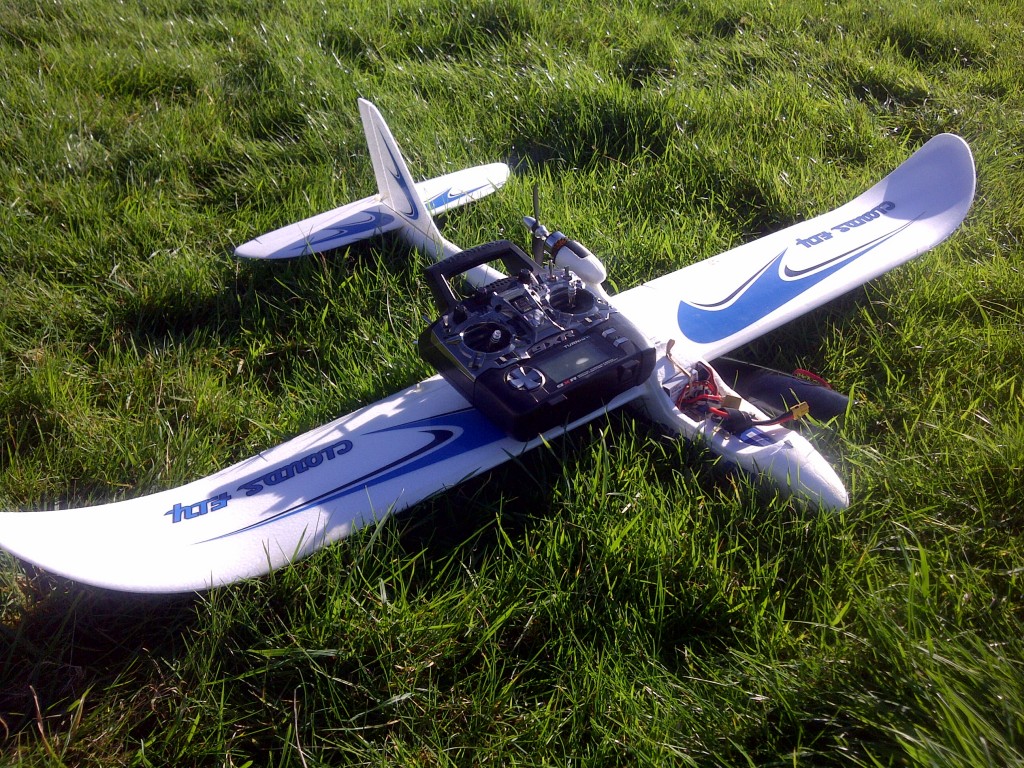
Several new models were flown in April, first up is Mike Smith with his Great Planes Tracer. The Tracer is a ‘proper’ plane, a balsa and ply kit of laser cut parts, that you have to glue together yourself and then cover.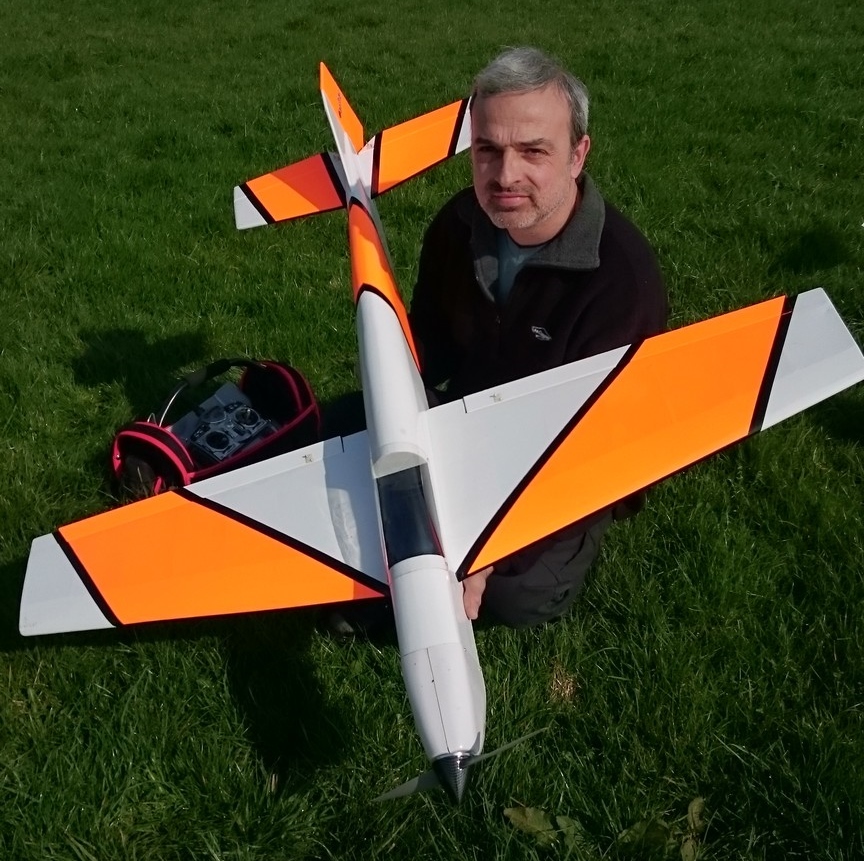
The model is 1335mm span and weighs around 2.4kg. It’s supposed to have a 40-51 cu.in I/C engine but of course Mike has converted it to electric. He also added electric retracts which seemed to work well on the test flight. The landing caught Mike out, he let the Tracer get a tad too slow but I don’t think there was any damage.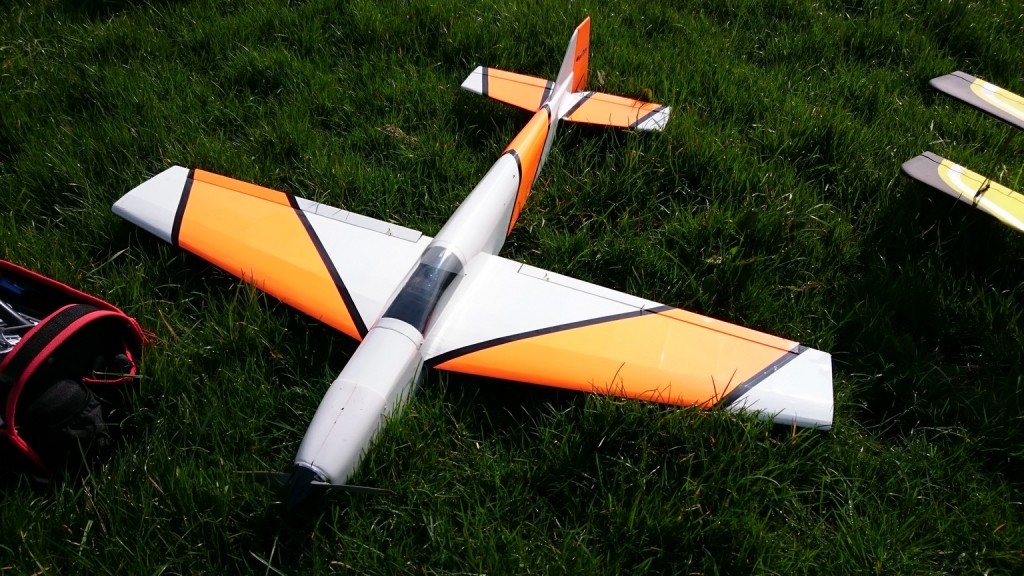
You can see some of the Tracer’s first flight and lots of other members and their models in THIS MONTHS VIDEO which you can see by CLICKING HERE
I included a photo of Dougal Entendre’s nose-less Spitfire in the March Patch News, the result of a cartwheel on take-off. Dougal was keen to explain that it went back together well and in the Comments section last month there was some discussion about paints and the different shades of grey on offer. He sent through some photos to show the end result, but I’m not certain his research was quite correct.
He sent through some photos to show the end result, but I’m not certain his research was quite correct.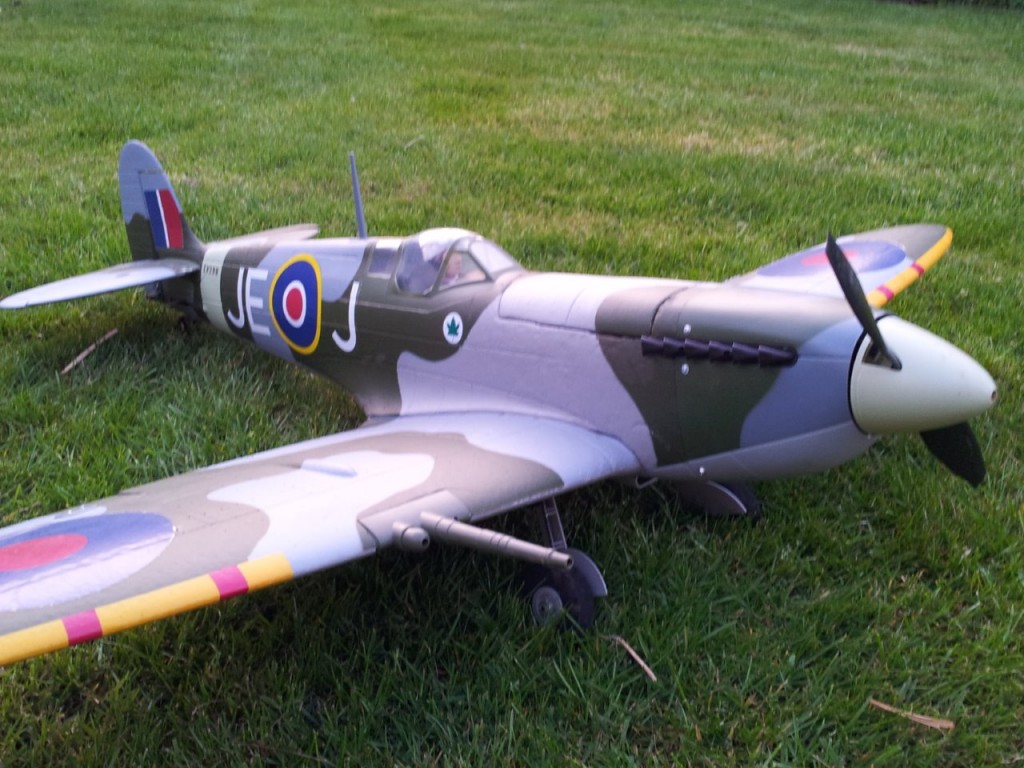
1066 has put together another HK 3D style model, this time it’s a Katana and he has set it up for a 4 cell lipo instead of 3. He still has the first pale green MXS, which flies very well, but I think this one looks better in red, white, and blue.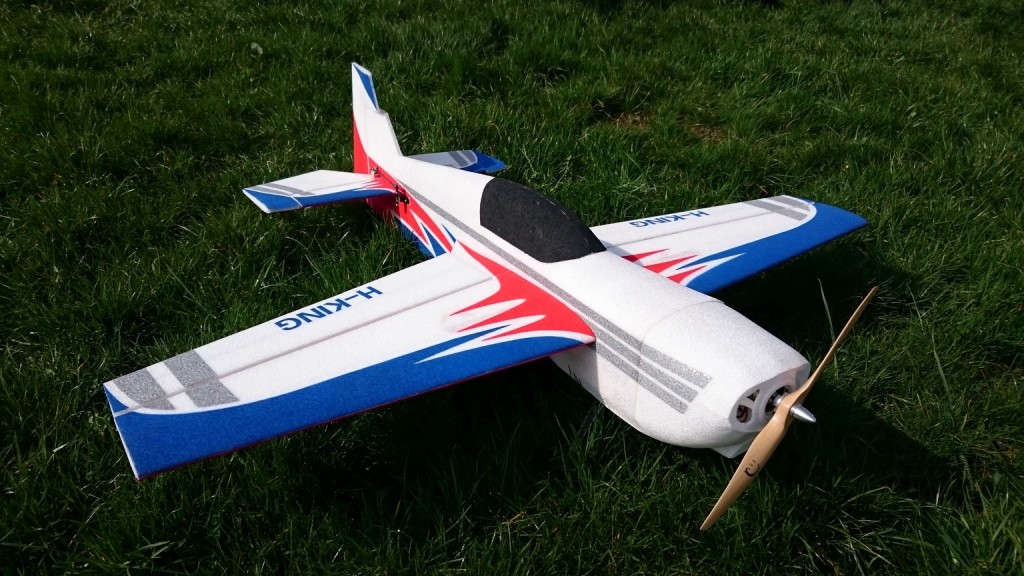 They are both of unusual construction; they have a lite-ply frame that is covered in EPP foam. It shows up well in the photo below, the manufacturer has even put lightening holes in the box that houses the wing joining tube which seems a little excessive to me.
They are both of unusual construction; they have a lite-ply frame that is covered in EPP foam. It shows up well in the photo below, the manufacturer has even put lightening holes in the box that houses the wing joining tube which seems a little excessive to me.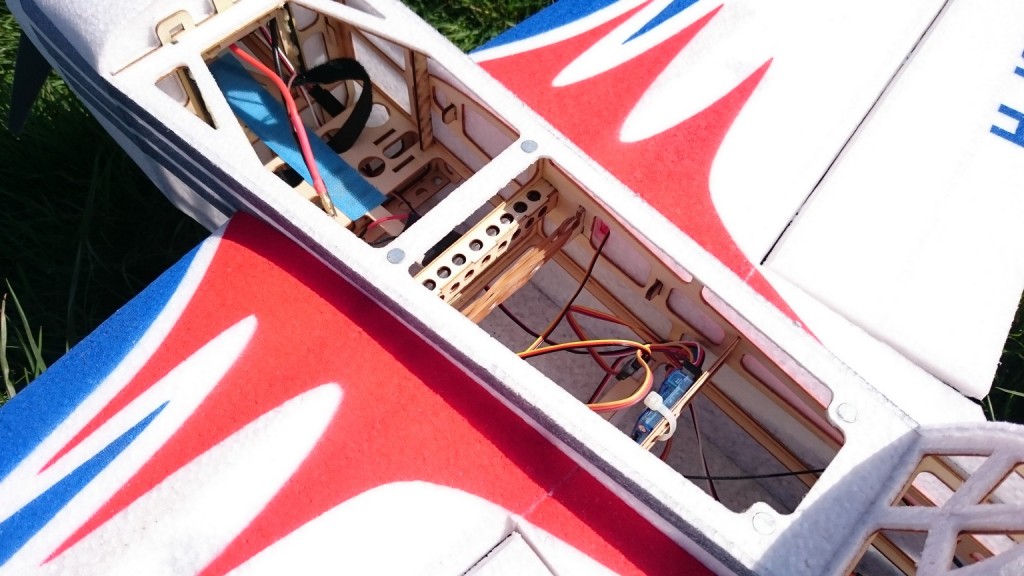 The Katana certainly performs well and can be seen in THIS MONTHS VIDEO.
The Katana certainly performs well and can be seen in THIS MONTHS VIDEO.
Smiffy is also known as The Invisible Man because he seems to disappear for a few months at a time, but he reappeared in April and flew on several days. As always, he had more equipment than I take when I go camping for a fortnight.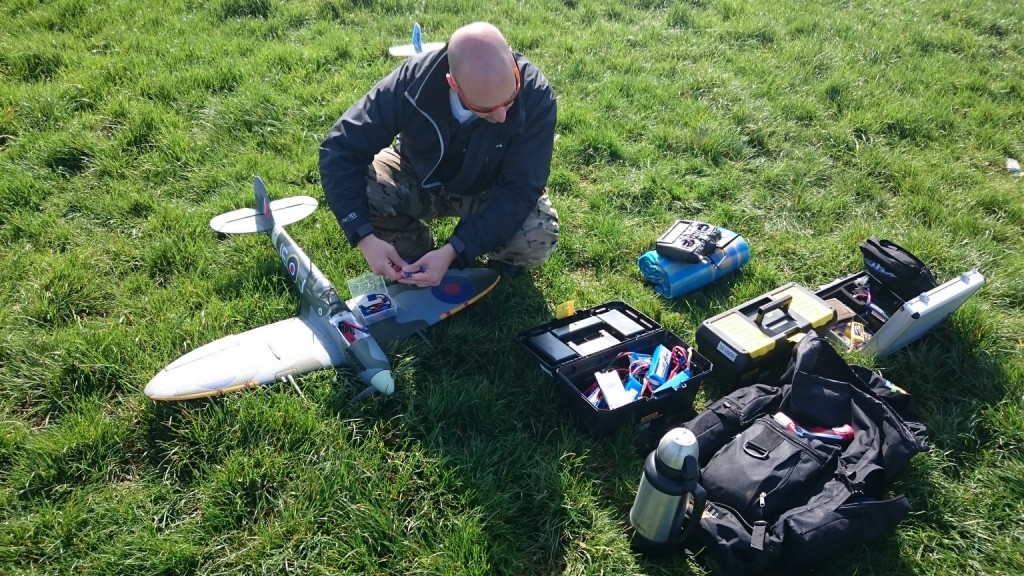 He brought along some models we’d seen before but also some new ones. When we all started flying the little Spirit Mini Sport electric gliders last year Smiffy called us clowns and the planes ‘Mini Gay Gliders’! Well, now he’s seen how they perform (I was brave enough to let him have a fly of mine) he’s a convert and has bought one himself. No doubt his will soon be fitted with an exotic hot motor and a 10 cell lipo but in the meantime he’s enjoying it in stock form. He also had a larger electric glider with him, a 2 metre span Kunlun 2000 from CM Pro. No, I’ve never heard of it either. It looks as if it should be a hotliner with its moulded fuselage but apparently the forums warn of overstressing the wings so Andy will have to be a little careful with it, more of a warmliner perhaps.
He brought along some models we’d seen before but also some new ones. When we all started flying the little Spirit Mini Sport electric gliders last year Smiffy called us clowns and the planes ‘Mini Gay Gliders’! Well, now he’s seen how they perform (I was brave enough to let him have a fly of mine) he’s a convert and has bought one himself. No doubt his will soon be fitted with an exotic hot motor and a 10 cell lipo but in the meantime he’s enjoying it in stock form. He also had a larger electric glider with him, a 2 metre span Kunlun 2000 from CM Pro. No, I’ve never heard of it either. It looks as if it should be a hotliner with its moulded fuselage but apparently the forums warn of overstressing the wings so Andy will have to be a little careful with it, more of a warmliner perhaps.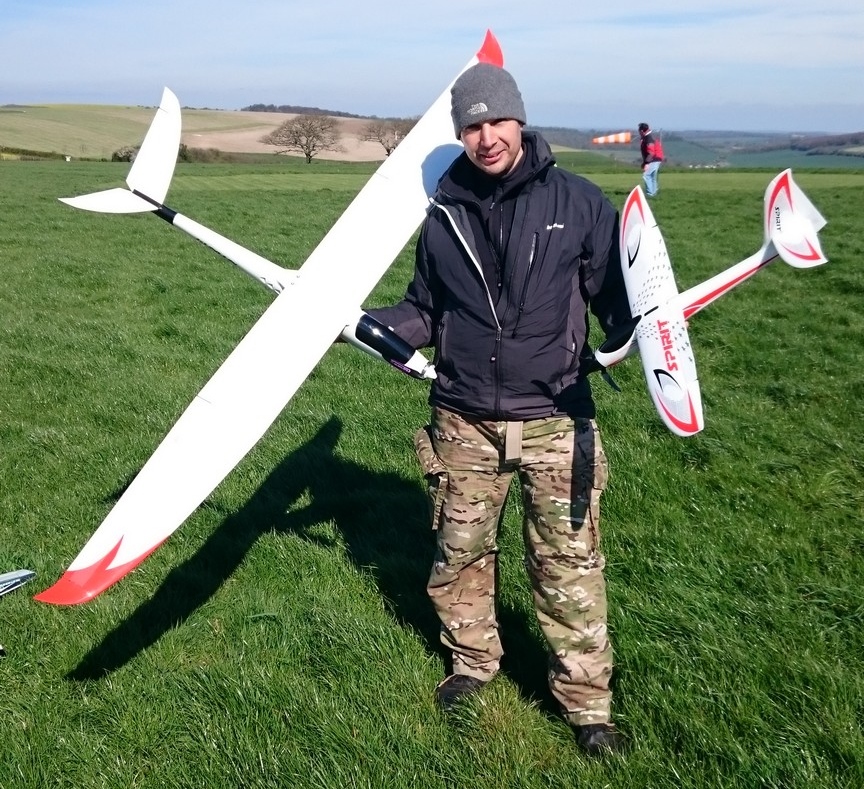 Following some advice found online he changed the tail configuration from a T-tail to a V-tail. The major reason for this was that the model comes out very tail heavy so removing the fibreglass fin and cutting the original tail-plane in half to use as a V-tail makes it possible to balance the model without needing loads of lead in the nose. He fitted a Dualsky 850kV motor, a 60A esc, and a 4 cell lipo driving an 11 x 6 prop but it was rather tame so he tried a 12 x 6 which was much better, and has ordered a 13 x 7 to try next. It looked pretty good to me although it would definitely benefit from having a bit more oomph. But try not to rip the wings off Smiffy.
Following some advice found online he changed the tail configuration from a T-tail to a V-tail. The major reason for this was that the model comes out very tail heavy so removing the fibreglass fin and cutting the original tail-plane in half to use as a V-tail makes it possible to balance the model without needing loads of lead in the nose. He fitted a Dualsky 850kV motor, a 60A esc, and a 4 cell lipo driving an 11 x 6 prop but it was rather tame so he tried a 12 x 6 which was much better, and has ordered a 13 x 7 to try next. It looked pretty good to me although it would definitely benefit from having a bit more oomph. But try not to rip the wings off Smiffy.
The final new model he flew was an E-flite Carbon-Z Yak 54 3X, bit of a mouthful so let me explain! The Carbon-Z part refers to the type of construction; apparently it’s extremely light whilst retaining the strength for violent manoeuvres. The 3X part of the name only applies if you either buy the BNF (Bind-N- Fly) version or fit a Spektrum AS3X-AR635 receiver to the PNP (Plug-N-Play) version. AS3X is Artificial Stabilization 3 aXis, in other words the receiver has a built in 3 way gyro that can be programmed in different ways, either to provide extra stability or to give enhanced agility. Smiffy bought the PNP version and as he uses Hitec radio gear he doesn’t have the gyros.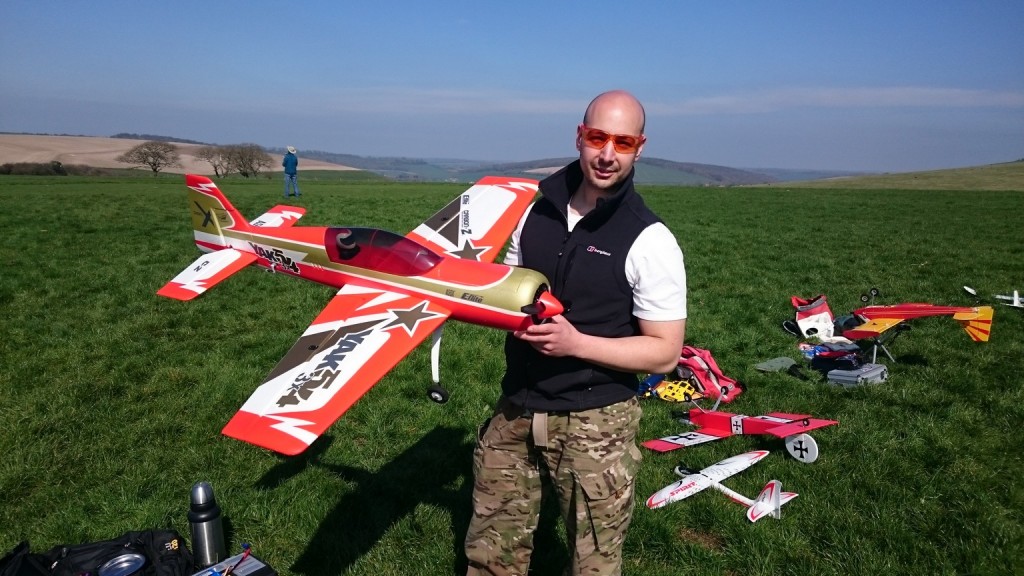 Anyway, it’s a Yak 54, 1220mm span, is fitted with a 25 size 1000kV motor and runs on 4 cells. Following his usual very thorough pre-flight checks Smiffy attempted the first take-off only to find the motor was running backwards. Obviously we were all very sympathetic and barely mentioned it!
Anyway, it’s a Yak 54, 1220mm span, is fitted with a 25 size 1000kV motor and runs on 4 cells. Following his usual very thorough pre-flight checks Smiffy attempted the first take-off only to find the motor was running backwards. Obviously we were all very sympathetic and barely mentioned it!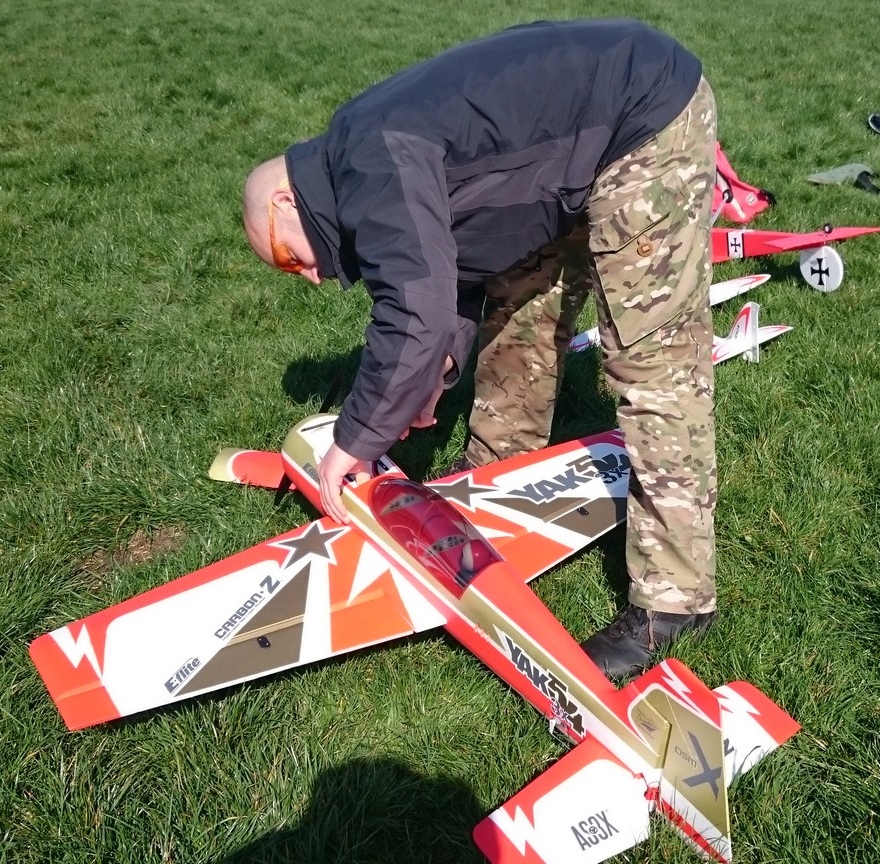 I was videoing at the time so you can enjoy the moment in THIS MONTHS VIDEO. Once the motor was sorted the Yak flew well and should be a really good 3D machine when Smiffy gets used to it.
I was videoing at the time so you can enjoy the moment in THIS MONTHS VIDEO. Once the motor was sorted the Yak flew well and should be a really good 3D machine when Smiffy gets used to it.
The Spirit motor doesn’t seem to be available as a spare so my own Spirit has been fitted with a Kinetic motor and prop after the original failed. A couple of weeks ago it threw a prop blade and the imbalance tore the motor mount clean off the fuselage, destroying most of the foam around the area. Whilst ordering a pair of prop blades I noticed HK also stock the Kinetic motor mount which, unlike the Spirit one, has a couple of side cheeks that fit around the nose. Fitting this to the Spirit strengthens the nose generally and in my case made the nose rebuild much simpler.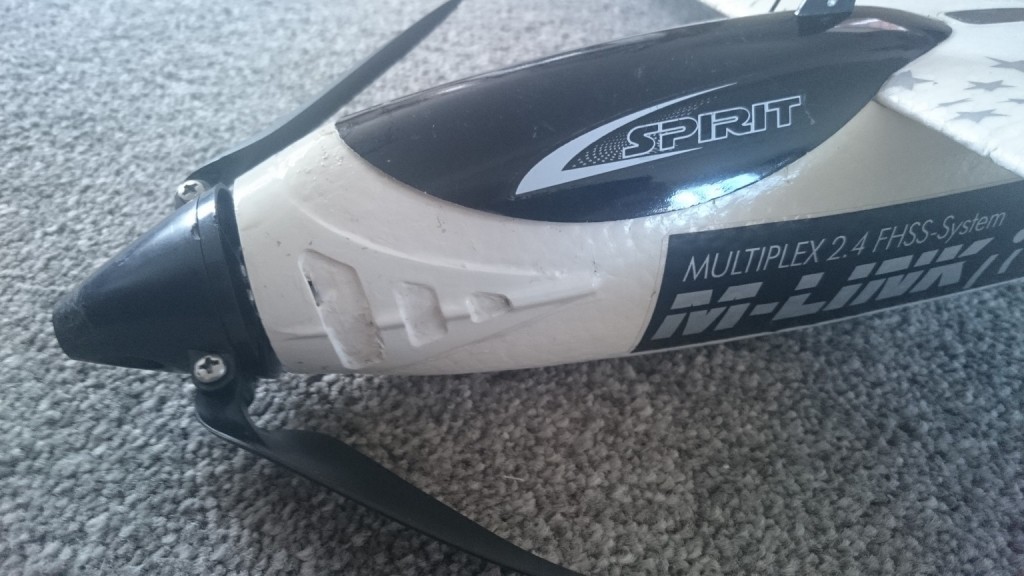 I took the opportunity to tidy up the fuselage front with a bit of filler, some acrylic paint, and a couple of new stickers.
I took the opportunity to tidy up the fuselage front with a bit of filler, some acrylic paint, and a couple of new stickers.
John Warren has been successfully flying an old biplane for a long time, in fact it first flew over 20 years ago when it was I/C powered. It’s a Sunday Flyer, designed by Mike Conrad in 1989 and described as a vintage style sports biplane. John converted it to electric power when he joined us at PAM but until recently it has only had rudder and elevator controls, no ailerons. Then, a few weeks ago John decided that it might be worth trying to fit some ailerons and I suggested it would be pretty straightforward to build a new bottom wing incorporating them. But John had other ideas; he simply tacked some ailerons onto the trailing edge of the existing wing!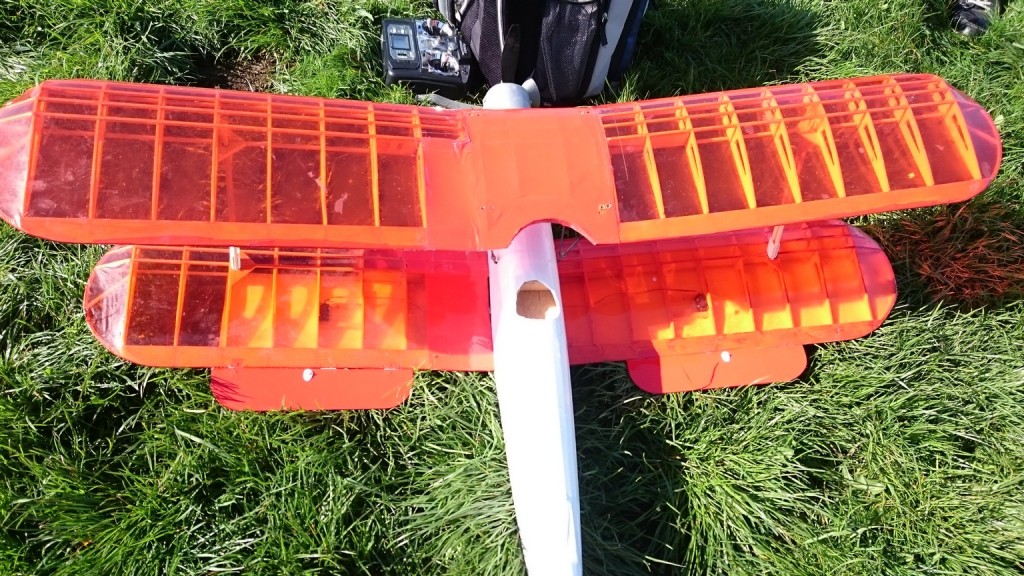 Despite my mockery of the end result John asked me to test fly the plane and I found that, surprisingly, the ailerons worked well and the model was much more precise in its flying than before. John has now had several flights with it himself.
Despite my mockery of the end result John asked me to test fly the plane and I found that, surprisingly, the ailerons worked well and the model was much more precise in its flying than before. John has now had several flights with it himself.
Landing on the ship during the daytime is like sex, it’s either good or it’s great. Landing on the ship at night is like a trip to the dentist, you may get away with no pain, but you just don’t feel comfortable. — LCDR Thomas Quinn, USN.
Colin Cowplain
Patch News – March 2015
Last week Dougal Entendre sent me something he found in the April 1983 Epsom Radio Flying Club newsletter that seems appropriate for this time of year, he thinks it was written by the then editor, one Chris Hodson:
“In the Spring a livelier iris changes on the burnish’d dove;
In the Spring a young man’s fancy lightly turns to thoughts of love.”
When Tennyson wrote this immortal verse, it is obvious that he wasn’t referring to an aero-modeller! Most hot blooded fliers that I have met certainly don’t need the spring to trigger off their thoughts of love. They attend to that during the winter months. When the spring comes there are far more important things to think about.
And here we are once again, with mother nature performing her annual miracle. The daffodils are already past their best – and the trees are alive with blossom to delight us all. So with the promise of good flying days ahead, it’s time to get those models down from the top of the wardrobe – check the radios, paint the airframes, and head for the flying field.
Had Tennyson been a member of our club, he might have written:-
“IN THE SPRING THE SUMMER EVENINGS PROMISE DAYS OF PURE DELIGHT.
IN THE SPRING THE AEROMODELLER LIGHTLY TURNS HIS THOUGHTS TO FLIGHT.”
Sadly it’s been blowing a gale almost constantly since I received Dougal’s email but spring really is here and the weather is going to turn glorious at any moment…
March started much the same as it ended, very windy, and, as I mentioned in last month’s Patch News, on 1st March I managed to video 1066 and Captain Slow braving the gale. Several others of us also flew but it was a bit of an endurance test at times! Steve was flying his 4 cell Speedy glider which proved to be the ideal model for the conditions. John flew his Zagi, which also seemed unperturbed by the gales. To see the video CLICK HERE
A few months ago I featured Captain Slow’s Ugly Stik (I think I could have put that better!) and mentioned that I quite fancied one myself but felt they were a little expensive. Well in early March HobbyKing had a sale and the Ugly Stiks were half price from the UK warehouse. That was too good to refuse and a couple of days later one duly arrived having cost just £47.15 plus postage. That is an amazing price as it includes the EPO airframe, motor, speed controller, four servos, and the dummy I/C engine. The electric motor is mounted inside the front of the fuselage with an extension shaft running through the plastic dummy I/C engine.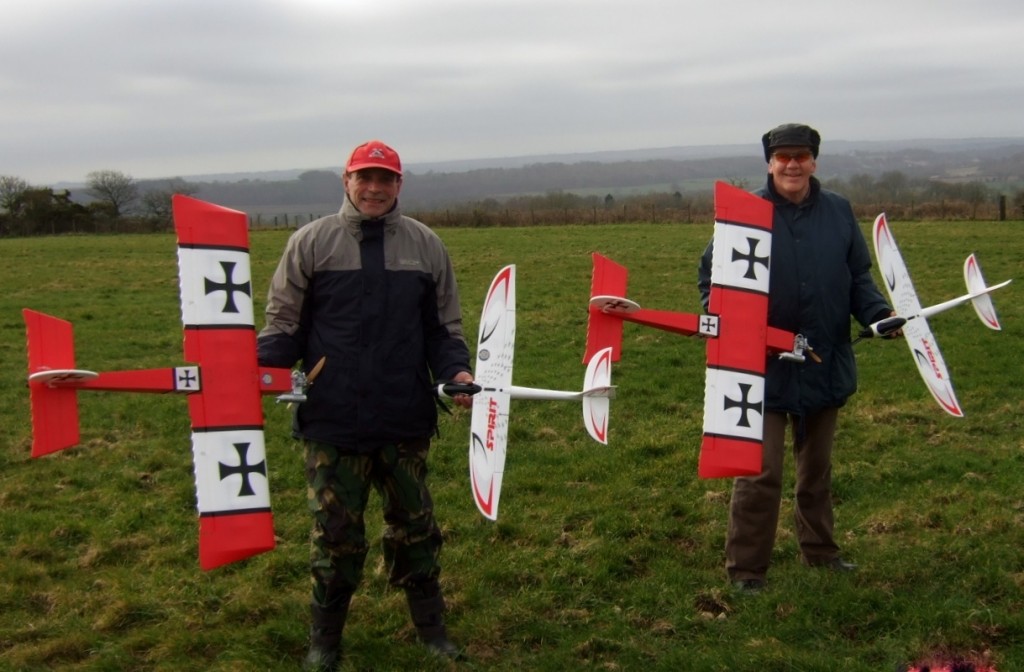 Me and my new best friend Captain Slow with Ugly Stiks and Spirits!
Me and my new best friend Captain Slow with Ugly Stiks and Spirits!
The instruction manual is surprisingly good and assembly consists of just eight points, one of which is to fit the prop ‘with the Durafly logo facing outwards’. At the back of the manual is a Trouble Shooting section and one item is: Problem – Model moves backwards. Cause – Prop installed backwards. Solution – Turn the prop around. Err…no, fitting the prop backwards results in greatly reduced power but it still pushes the air in the same direction! In the ‘good old days’ before radio control and throttles we would sometimes fit a prop on backwards to reduce the power of an overpowered free flight model.
The suggested battery is a 3 cell 25C 2200 lipo and I was a little concerned that my 3 cell 25C 4000s might cause CG problems even if they fitted ok, but I needn’t have worried, I can report that a 3 cell 25C 4000 Zippy Compact fits snuggly and the CG is spot on. The extra weight probably reduces the performance a tad but it seems to go well enough to me and the flight times are ridiculous, I tend to land after around 12 minutes and usually have well over 30% left in the pack.
Captain Slow took this as I prepared for the first flight.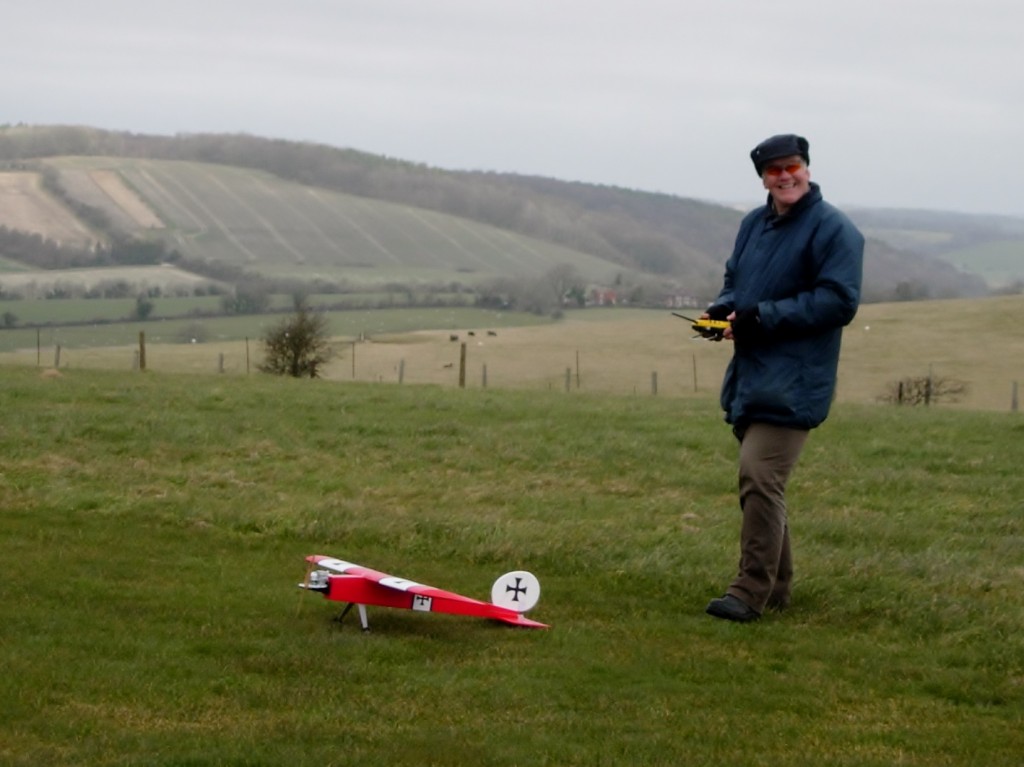
I had read reports of the bearing in the dummy I/C seizing and this can cause the esc to blow, possibly resulting in a loss of radio, so I was worried when mine suddenly made strange rev linked noises during the first couple of flights. I landed, checked all was ok, and took off again several times before discovering that the noise was caused by a piece of transparent film over the Durafly logo on the prop. The film had started to lift in the airflow and once these were removed from both blades the noise disappeared.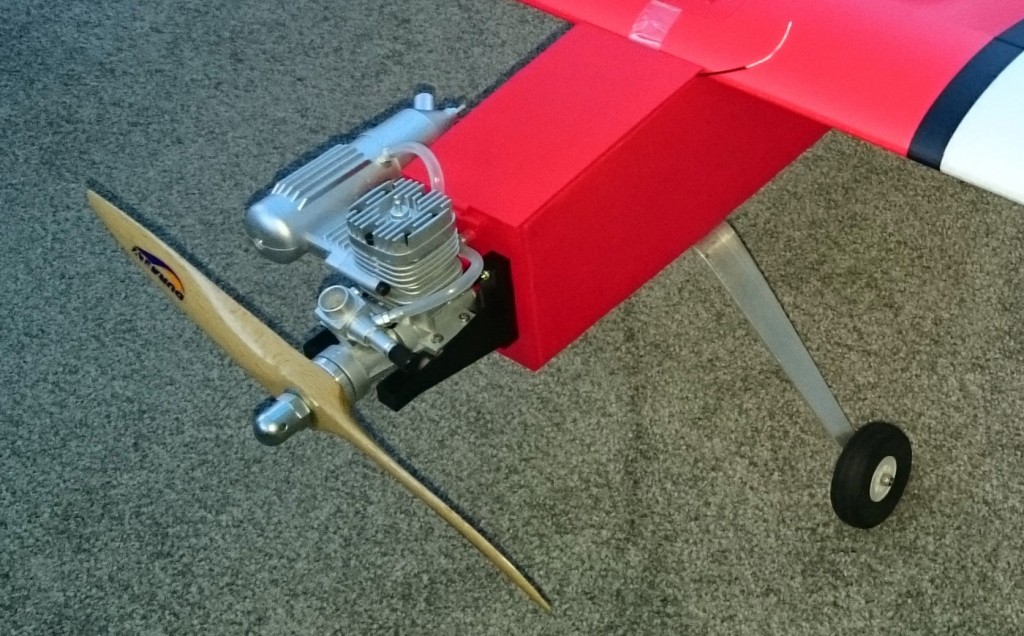 I’m still wary of the bearing seizing and have oiled it several times but so far I’ve had no problems. Like Captain Slow, I managed to pull the undercarriage out after a few flights. The landing really was quite gentle but the plastic undercarriage mounting is simply trapped between the two halves of the fuselage and doesn’t appear to have any glue on it all. So on the first landing that is anything less than perfect the plastic just pulls through the foam underside. Mine was soon put back in position but this time with copious amounts of Gorilla Glue. It’s stayed put for lots of flights since (including a touch and go) so I’m hoping it will be ok now. Fingers crossed…
I’m still wary of the bearing seizing and have oiled it several times but so far I’ve had no problems. Like Captain Slow, I managed to pull the undercarriage out after a few flights. The landing really was quite gentle but the plastic undercarriage mounting is simply trapped between the two halves of the fuselage and doesn’t appear to have any glue on it all. So on the first landing that is anything less than perfect the plastic just pulls through the foam underside. Mine was soon put back in position but this time with copious amounts of Gorilla Glue. It’s stayed put for lots of flights since (including a touch and go) so I’m hoping it will be ok now. Fingers crossed…
Away from aero-modelling the supposed highlight of March was the near total eclipse of the sun at 9.30am on 20th March. Some of us Midweekers decided to go to the patch a little earlier than usual, hoping to get a good view of the eclipse from high up on the downs and then fly from 10am as usual. Sadly the 100% cloud cover meant we saw absolutely nothing of the sun but we were amazed by just how dark it got up there. It was very eerie, there was total silence as it grew darker and darker, and the birds obviously thought it was nightfall. But, unlike them, we weren’t fooled, after a few minutes the daylight returned and we enjoyed the rest of the morning, flying as usual. Needless to say, later on the cloud broke and we saw the sun, typical!
But, unlike them, we weren’t fooled, after a few minutes the daylight returned and we enjoyed the rest of the morning, flying as usual. Needless to say, later on the cloud broke and we saw the sun, typical!
Last month I said that Woody (Alan Wood) had replaced his much loved Seagull Pilatus PC9 with a… Seagull Pilatus PC9, but I had forgotten to photograph it. Well here it is, having corrected the CG it’s now flying just like the first one and we have a happy Woody once again.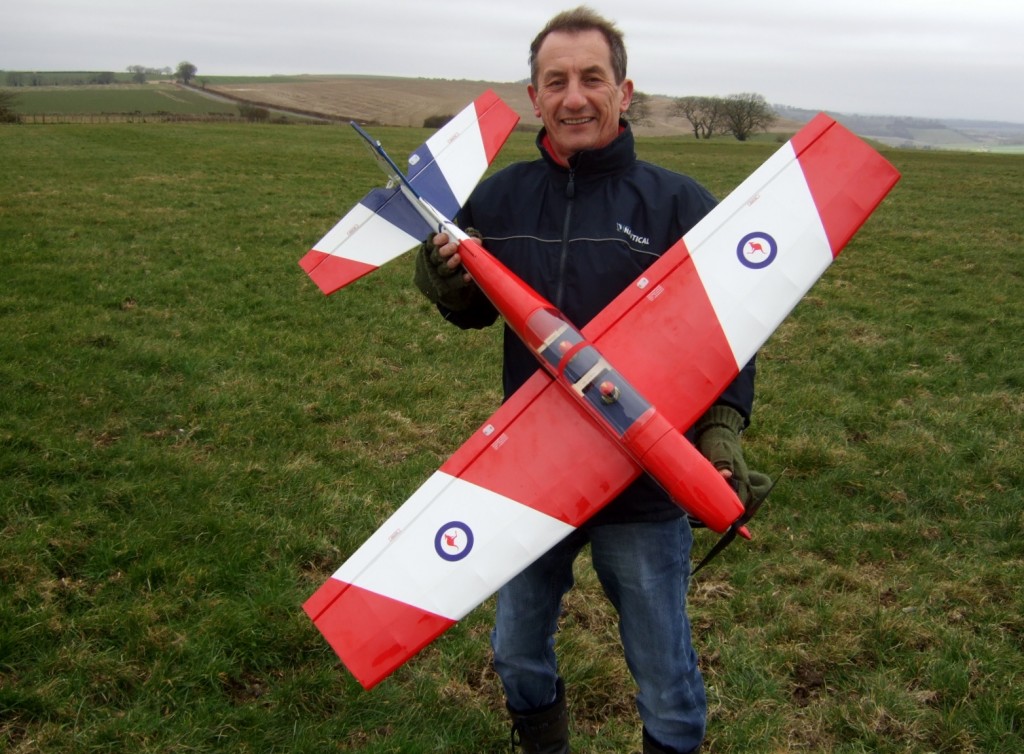
Chairman Ron also likes the Seagull PC9, so much so that he actually has two of them. They have very lightweight ‘traditional’ built up structures which are covered in Oracover. I thought they might be a little fragile when I first saw them but in fact they have proved to be pretty durable, light but strong. They are excellent fliers and both Woody and Ron praise them highly. At just under £70 from Kings Lynn Model Shop what’s not to like?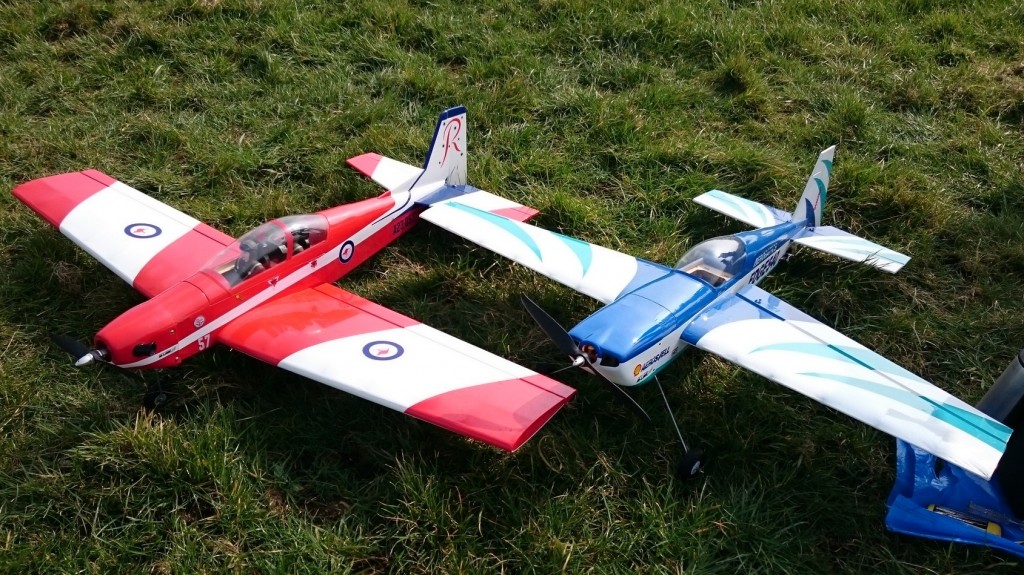
Accompanying Ron’s PC9 in the photo is his Edge 540. This is another Seagull model with a similar light but strong structure and it also flies very well. Both models use the almost standard 3 cell 2200 lipo packs although the Extra can take 4 cells for those that want more extreme performance.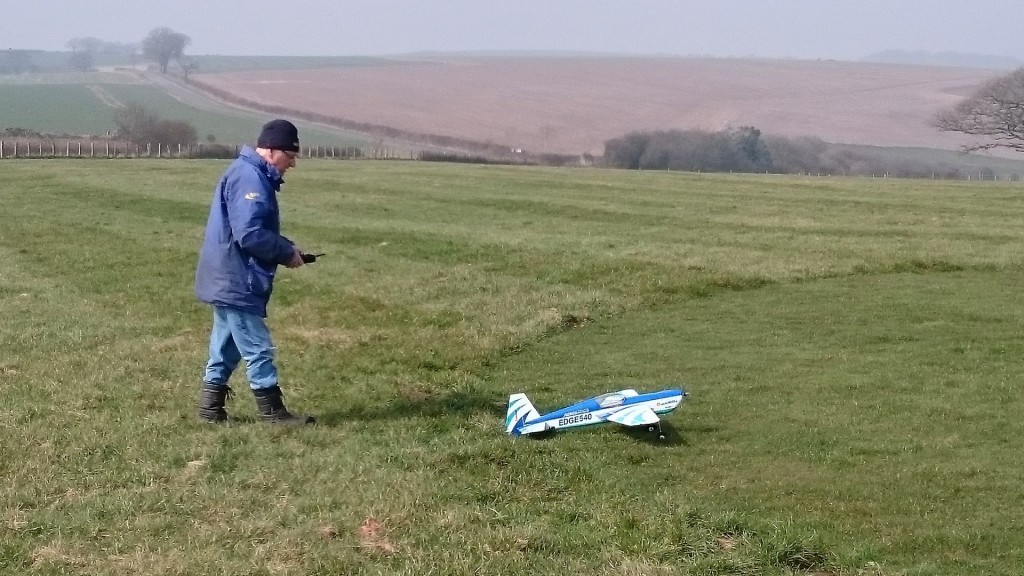 Ron’s Edge 540 also came from Kings Lynn Model Shop and if you’d like one, at £71.99 they are just £2 dearer than the PC9.
Ron’s Edge 540 also came from Kings Lynn Model Shop and if you’d like one, at £71.99 they are just £2 dearer than the PC9.
On 15th March the weather was windy (again) so not many fliers showed up but it turned out to be an interesting morning as the bottom lane was on the route of the Meon Valley Plod organised by Portsmouth Joggers. This was interesting not only because we were able to watch people even dafter than ourselves enjoying their sport but also because Dougal’s wife Angie was one of them! We lined up alongside the fence to cheer Angie on as she ran past, and then retreated to the comfort of our cars and home for a warm up.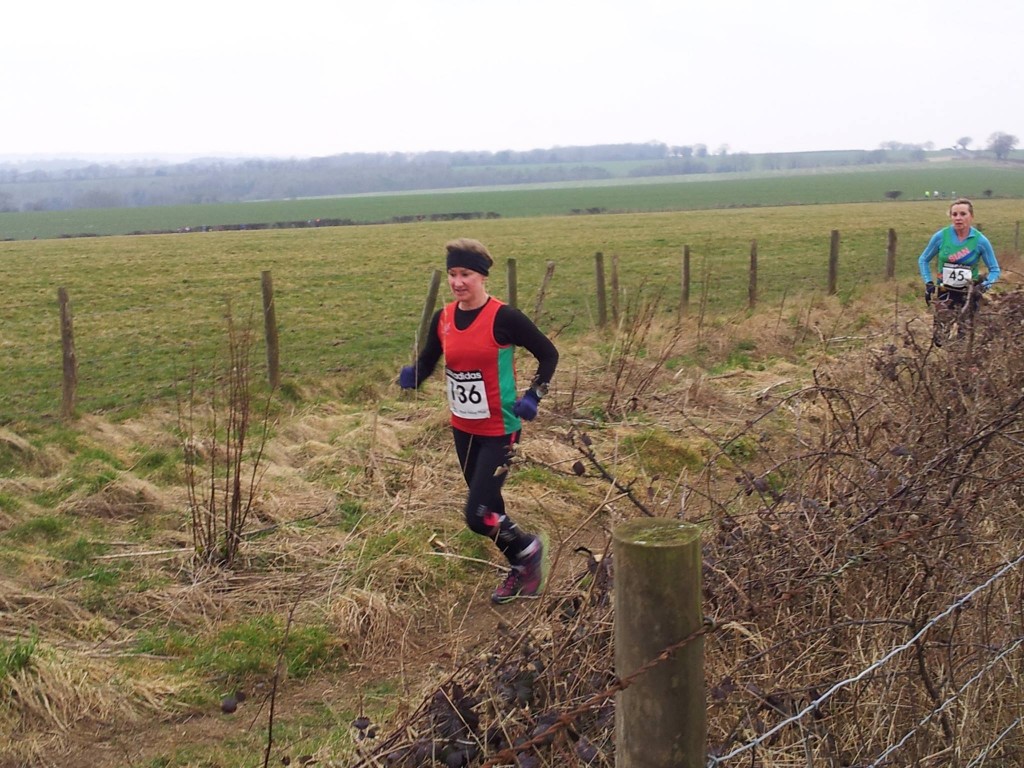 The Plod is a very muddy cross-country run of just over 21 miles featuring six big hills with a total ascent of 2300ft…they must be mad! As she passed us Angie said she was struggling but she finished roughly in the middle of the pack with a time of 3 hours 37 minutes so very well done to her I say.
The Plod is a very muddy cross-country run of just over 21 miles featuring six big hills with a total ascent of 2300ft…they must be mad! As she passed us Angie said she was struggling but she finished roughly in the middle of the pack with a time of 3 hours 37 minutes so very well done to her I say.
On the same day the other Agate (Dougal) didn’t do so well. As I said, it was very windy and as he attempted to get his Spit off the ground the wind got under one wing and it cartwheeled. Spitfires with scale retracts are notoriously difficult to get off the ground safely, they always try to ‘peck’ the prop into the ground and the pilot has to try to stop it by holding full up elevator until the speed has risen. Then, unless the elevator is perfectly managed, the plane jumps into the air with insufficient airspeed and there are dire consequences.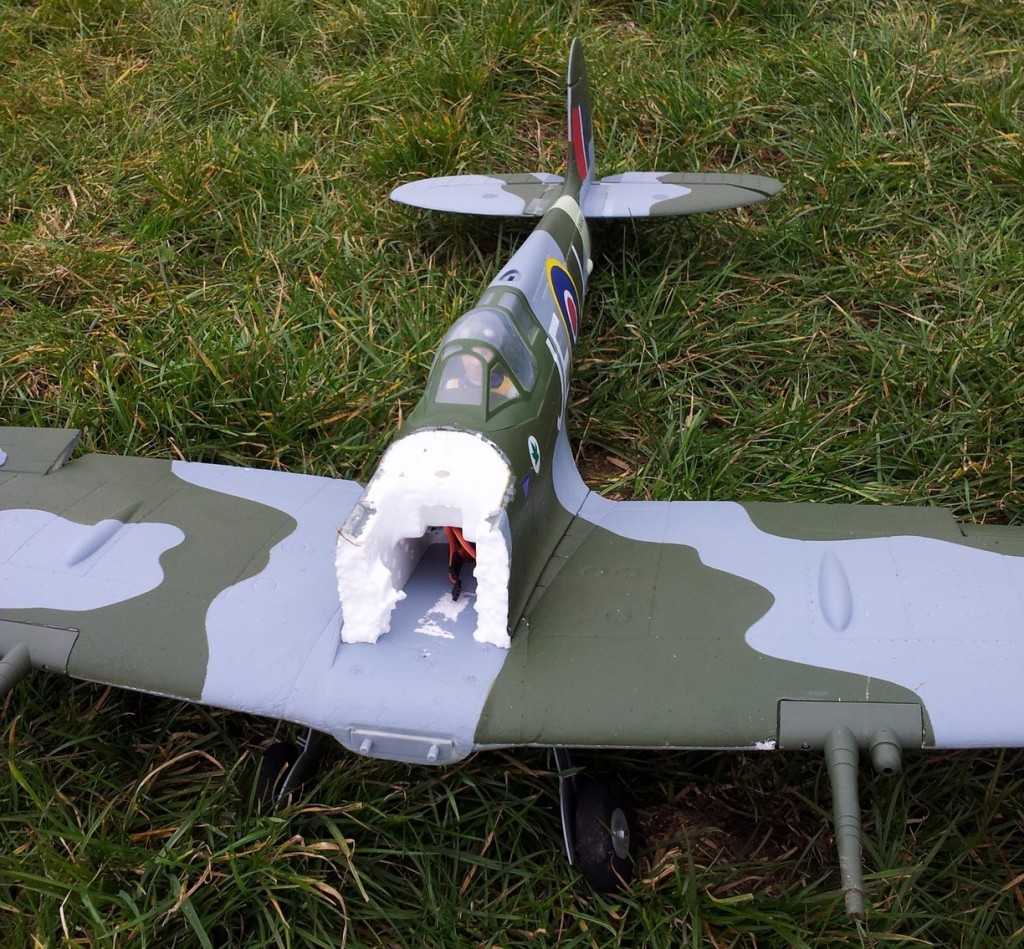 In calm weather Dougal often hand-launches his Spit with the wheels retracted as it’s impossible to stop it nosing in, but he thought he may have more control in the strong wind. Sadly he was wrong, but not to worry, the damage looked worse than it really was and Dougal reports the nose simply glued straight back in position with barely a mark to see.
In calm weather Dougal often hand-launches his Spit with the wheels retracted as it’s impossible to stop it nosing in, but he thought he may have more control in the strong wind. Sadly he was wrong, but not to worry, the damage looked worse than it really was and Dougal reports the nose simply glued straight back in position with barely a mark to see.
Stanley Knife (Viv Burgess’ new self-imposed nickname) flew his large Stinson Reliant on one of the calmer midweek days. The model was designed to have a 160 I/C motor but Stanley has converted it to electric. 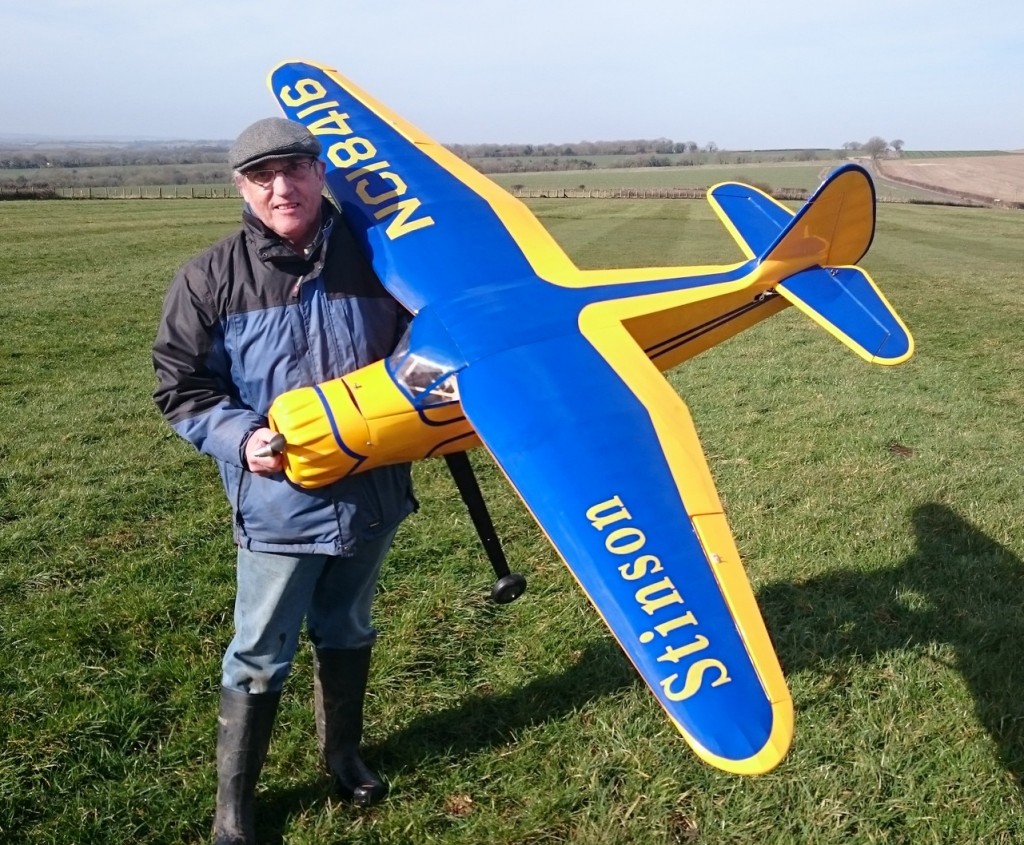 It has loads of power and flies very well but Stanley is still finalising elevator movement and CG position as the model seems very sensitive to down elevator. So far, despite the motor producing around 2.7kW of power on 10 cells, each time Viv has landed after flights of around 5 minutes there has been around 80% left in the batteries. Once off the ground Stanley throttles back and the Stinson cruises round very regally.
It has loads of power and flies very well but Stanley is still finalising elevator movement and CG position as the model seems very sensitive to down elevator. So far, despite the motor producing around 2.7kW of power on 10 cells, each time Viv has landed after flights of around 5 minutes there has been around 80% left in the batteries. Once off the ground Stanley throttles back and the Stinson cruises round very regally.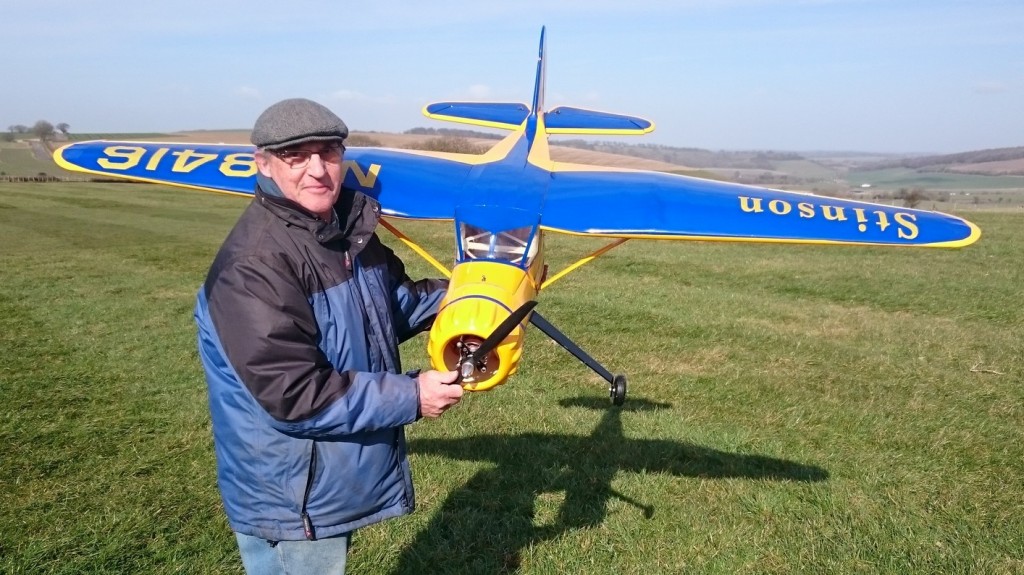 On the last flight it suffered the usual ARTF undercarriage failure despite a reasonable landing but it was soon repaired and strengthened somewhat. I took some video of Stanley’s’ latest flight (including that landing) and have compiled it with various others taken in March, including Gentleman Jim, Chairman Ron, and Mike Smith’s new Pitts Python. To watch the video CLICK HERE
On the last flight it suffered the usual ARTF undercarriage failure despite a reasonable landing but it was soon repaired and strengthened somewhat. I took some video of Stanley’s’ latest flight (including that landing) and have compiled it with various others taken in March, including Gentleman Jim, Chairman Ron, and Mike Smith’s new Pitts Python. To watch the video CLICK HERE
Last week I was looking forward to seeing Mike Smith test fly his new Great Planes Tracer aerobatic model that he’s converted to electric, but when he arrived at the patch he was carrying a biplane instead. Turns out he’d got the Tracer out of the car only to discover he’d left the wing bolts at home. What sort of an idiot does that…apparently almost all of us at some time or other! The biplane turned out to be a Dynam Pitts Python, a new model Mike that had recently purchased.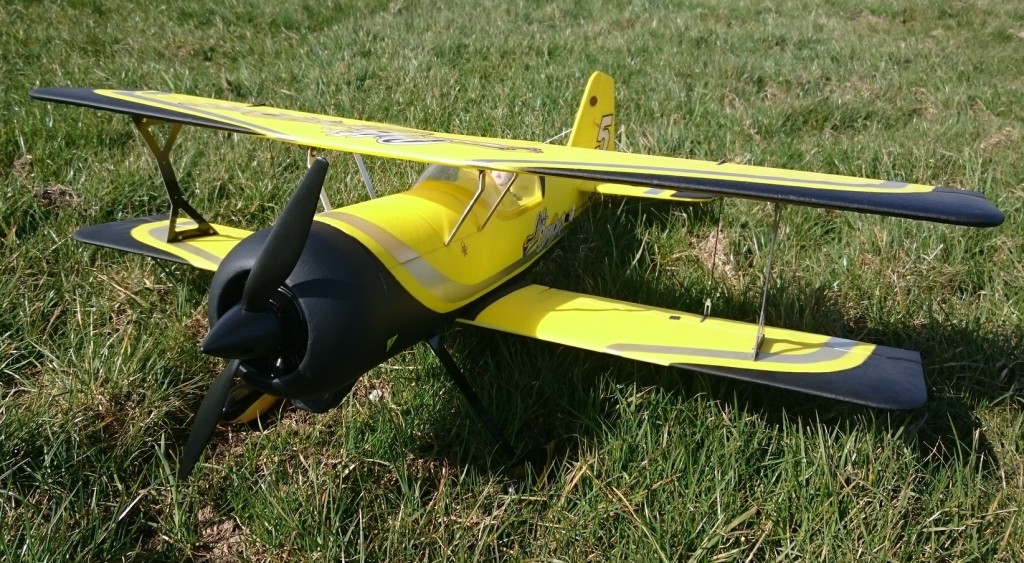 The original was designed by Curtis Pitts of course and the Python version was fitted with a Russian radial engine which gave it a superb power to weight ratio. The Dynam model is 1067mm span and only weighs 1300g so running a 650kVa motor on 4 cells means it also has a superb power to weight ratio.
The original was designed by Curtis Pitts of course and the Python version was fitted with a Russian radial engine which gave it a superb power to weight ratio. The Dynam model is 1067mm span and only weighs 1300g so running a 650kVa motor on 4 cells means it also has a superb power to weight ratio.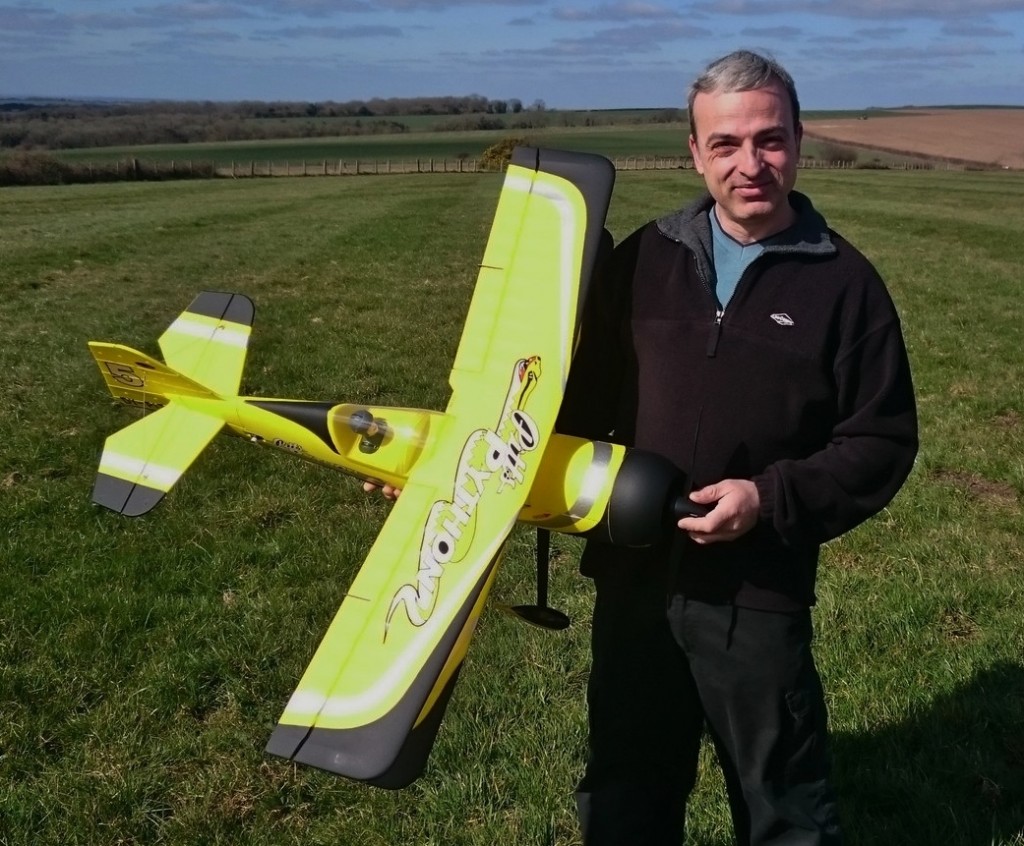 Mike spent most of the morning plucking up the courage to fly his new pride and joy so he only had one flight but I’m happy to report that all went well. Being the first flight Mike didn’t do anything dramatic with the model but it certainly appears to fly well, has loads of power, and will obviously be a very capable performer.
Mike spent most of the morning plucking up the courage to fly his new pride and joy so he only had one flight but I’m happy to report that all went well. Being the first flight Mike didn’t do anything dramatic with the model but it certainly appears to fly well, has loads of power, and will obviously be a very capable performer.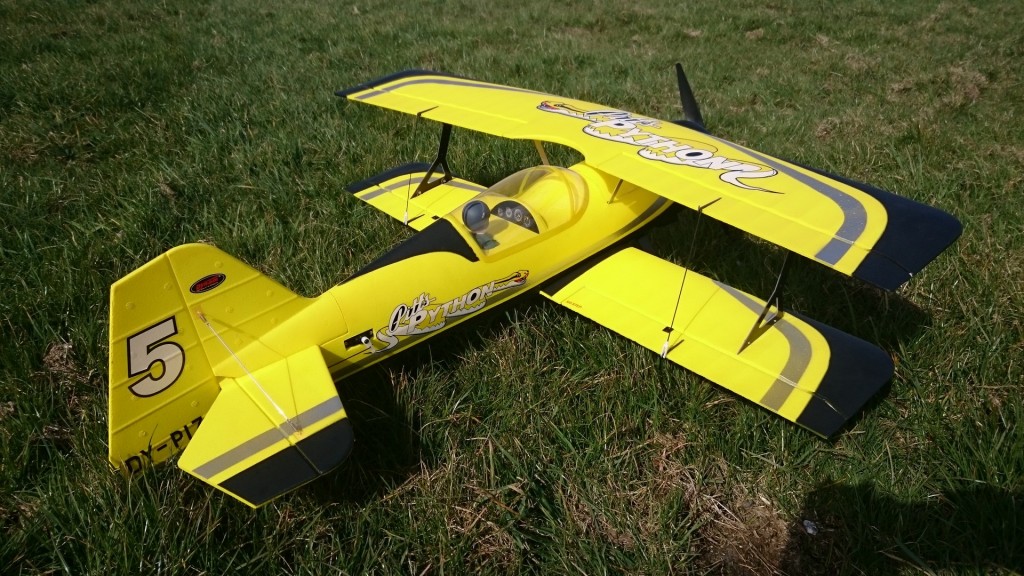 Snippets of the first flight can be seen in the video mentioned in the previous section.
Snippets of the first flight can be seen in the video mentioned in the previous section.
On the subject of Pitts, for those of you that I haven’t bored to death with the story, in 2010 I was bought an hour long aerobatic flight in a Pitts Special for my 60th birthday (yes, I know, I can’t possibly be that old etc…) and had a great time. It was from Rochester Airport in Kent with a pilot who competes in the British Aerobatic Association events in Pitts G-TIII. He let me fly a large part of the flight on the way to the aerobatic area on the Kent coast, then did all the usual gut wrenching things an aerobatic pilot does in a Pitts, and then let me fly most of the way back to Rochester. Amazing flight and no I wasn’t sick! The plane is currently up for sale so if you’d like your own Pitts and have £50k spare I can give you a phone number. If you’d like to see a video I did of the day CLICK HERE
Last week we had a lovely day with a reasonable wind that was in a perfect direction for the Sky Surfing Club who use Wether Down, up by the radio masts. We mostly see paragliders nowadays but the wind that particular day must have been better suited for hang gliders as lots of them were soon aloft and several found enough lift to leave the ridge and thermal soar away from the hill.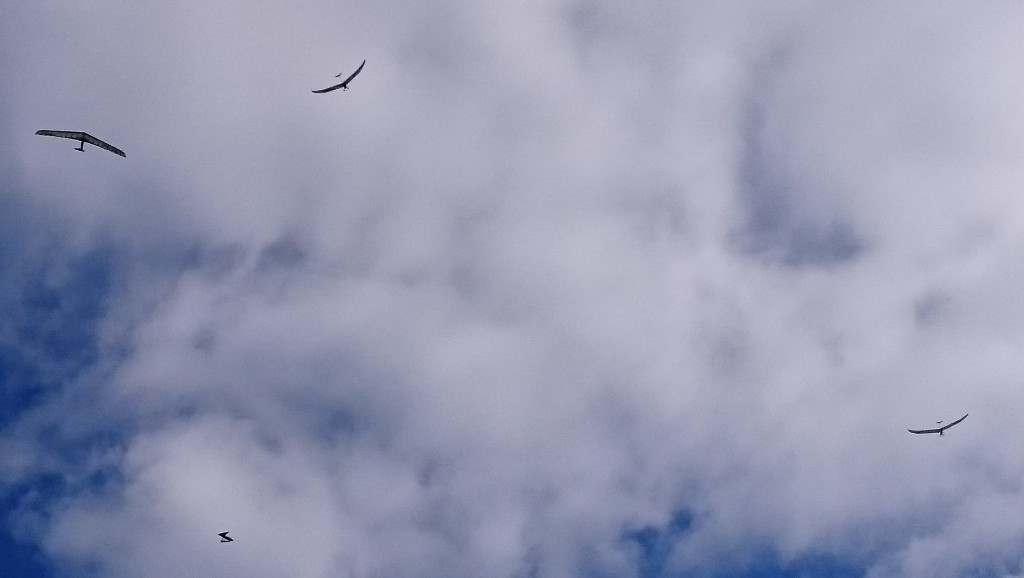 They gradually drifted southwards, circling in the thermals and passed over our field to the east of the pits. Obviously we kept a good lookout all the time they were in our vicinity but none of them ever got close to the area the models were flying in. They are fascinating to watch and have advanced hugely from the early days of Rogallo wings, they are now high tech, high performance machines.
They gradually drifted southwards, circling in the thermals and passed over our field to the east of the pits. Obviously we kept a good lookout all the time they were in our vicinity but none of them ever got close to the area the models were flying in. They are fascinating to watch and have advanced hugely from the early days of Rogallo wings, they are now high tech, high performance machines.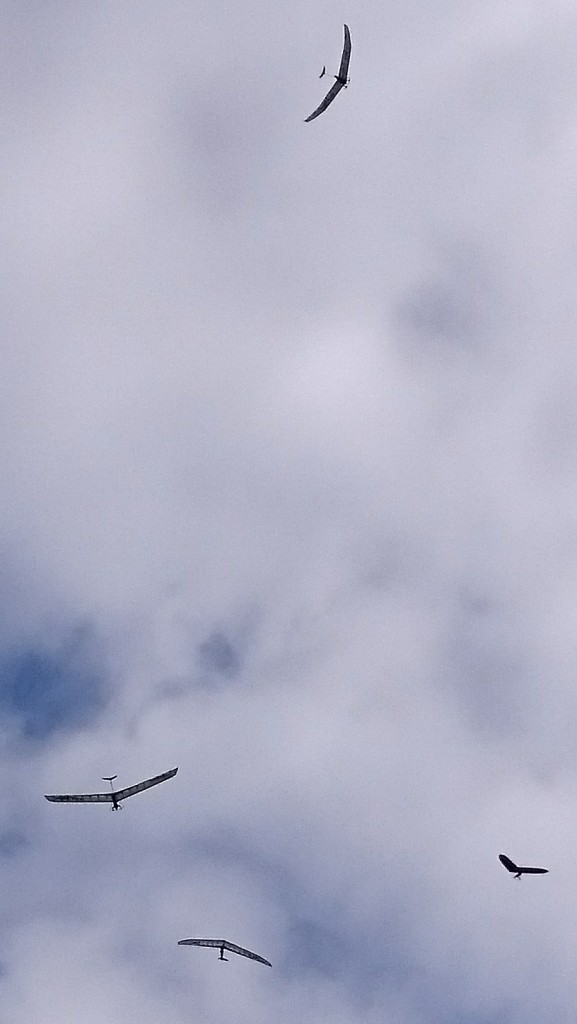
The photos aren’t of brilliant quality but you can clearly see that they have some form of tailplane and reflexed wing tips. It was great to be able to watch a totally different type of aviation whilst enjoying our model flying.
With the upcoming election in mind the sign on the back of one of those trucks that sucks out the waste from airliner toilets seems appropriate: ‘Caution – This truck is full of political promises’
Colin Cowplain
Patch News – February 2015
It’s the beginning of March and the signs of spring are here, roll on summer! February gave us the expected mixture of weather, some days were just wet and awful, others were cold but clear, but the overall trend seemed to be windy.
February 1st in particular was VERY windy, only an idiot would have bothered trying to fly…well it seems we have two idiots, Captain Slow (John Wheeley) and Dougal Entendre (Mark Agate). Perhaps I should mention that the nicknames are mostly not ones I have dreamt up, they are what people have chosen to call themselves. Anyway, said idiots both flew their little Spirit electric mini-hotliners and Dougal sent the photographic evidence.
Anyway, said idiots both flew their little Spirit electric mini-hotliners and Dougal sent the photographic evidence.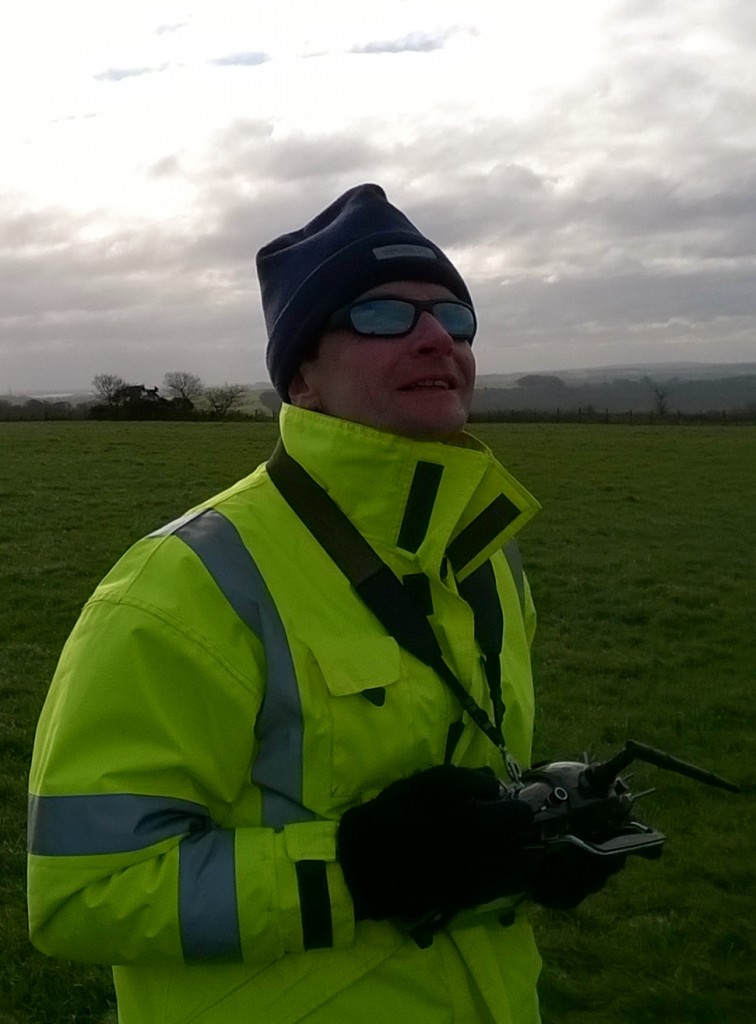 He reports that the wind was typically 25 knots with gusts up to 38 knots but the Spirits took it in their stride!
He reports that the wind was typically 25 knots with gusts up to 38 knots but the Spirits took it in their stride!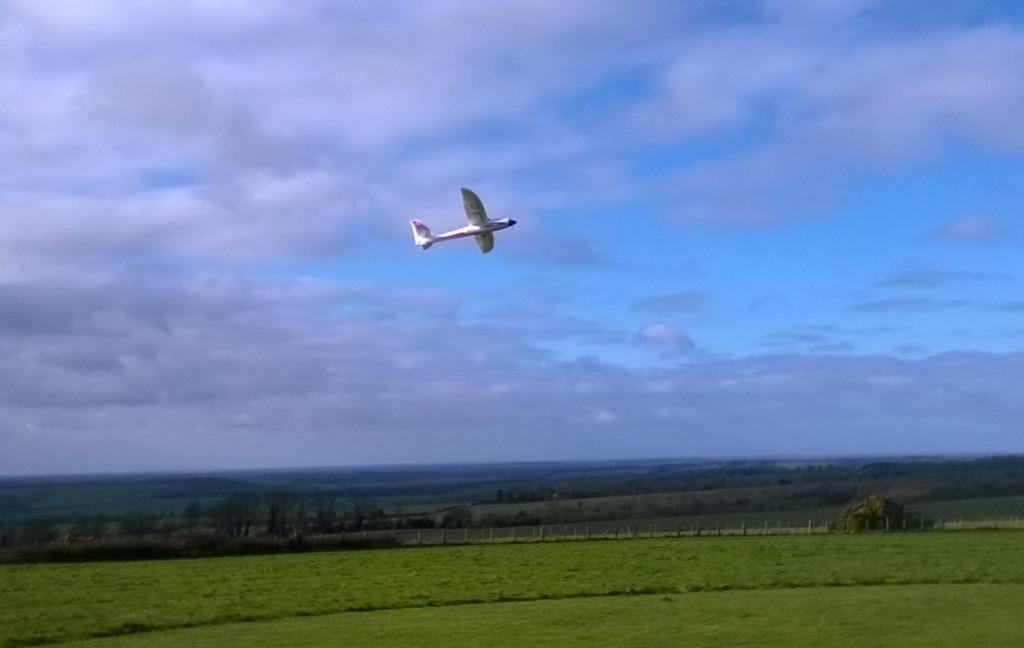
We all tend to struggle with watery eyes when trying to fly in really windy weather. Personally I wear sunglasses all year round and find that they control the watering. Steve 1066 Hastings struggles more than most and was seen this month testing yet another solution.
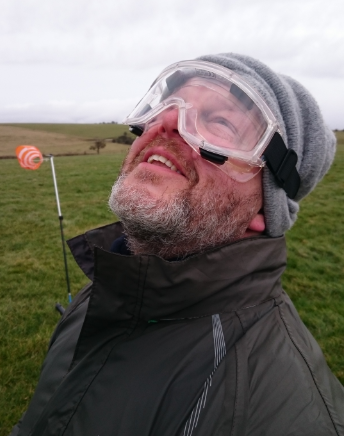
Not your best look Steve but if it works for you…
Last month I briefly mentioned the Citabria Pro that Dwayn Pipe (Keith Evans) had built but as he was planning to give a talk at club about building the model I didn’t go into any detail.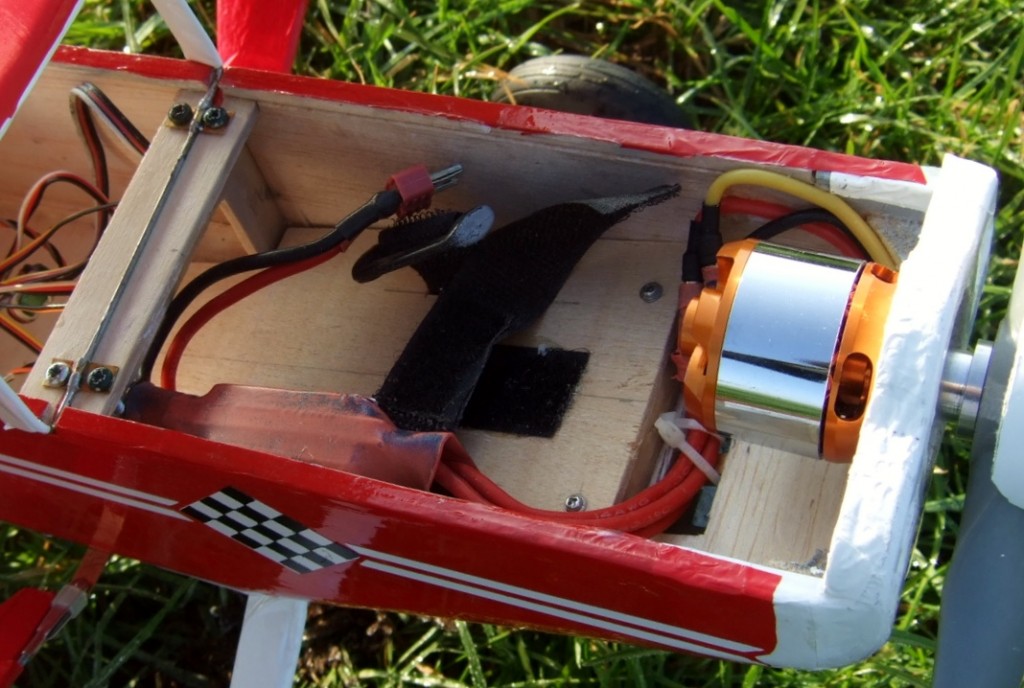 The talk was excellent and gave a good insight into building from a plan, including such things as creating a materials list and cutting a kit of parts before commencing the build.
The talk was excellent and gave a good insight into building from a plan, including such things as creating a materials list and cutting a kit of parts before commencing the build.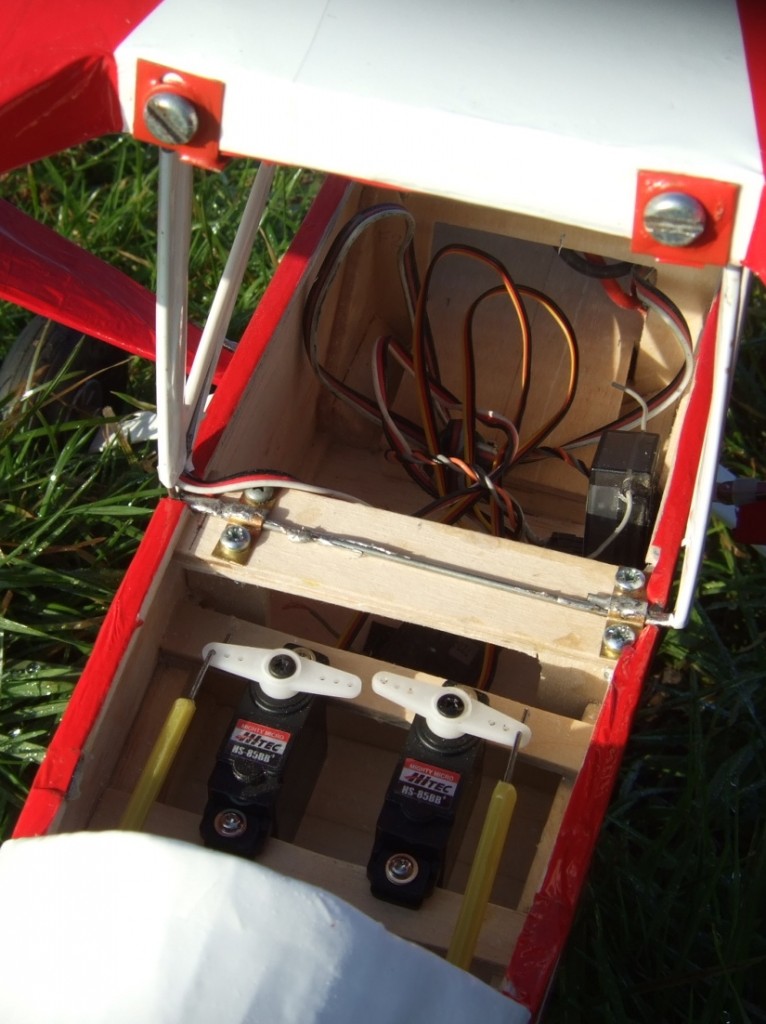 Following the first flight Keith has made a few adjustments to such things as the motor downthrust etc and the Citabria has now had several more successful flights. I managed to get some reasonable video of one flight which you can see here: Citabria video
Following the first flight Keith has made a few adjustments to such things as the motor downthrust etc and the Citabria has now had several more successful flights. I managed to get some reasonable video of one flight which you can see here: Citabria video
I also mentioned last month that Dougal has been messing around with some new firmware on his Walkera Devention transmitter which has meant overwriting every model setup. So he has been giving all of his many models a fresh ‘first flight’ to trim them and get the control movements he likes. Dougal seems to have gone with the approach of starting with the maximum movement possible on all surfaces with no exponential, and then taming them back to something more comfortable. This has resulted in some amusing moments for us spectators and having watched some of his tests I decided to record the ‘first flight’ of his Slick.
I only managed the first few seconds as I was laughing so much: Slick video
One of the PAM members who braved the winds several times in February was Gary Houghton. Gary is the last remaining regular I/C flier but I understand an electric model is currently under construction.
He is seen here with his Chris Foss Wot 4 and he also flies a Weston Cougar 2000.
Steve 1066 Hastings has been enjoying his Speedy electric glider this month. The model has a 1600mm span built up balsa wing and a fibreglass fuselage, and is sold by HobbyKing as a 3 cell model.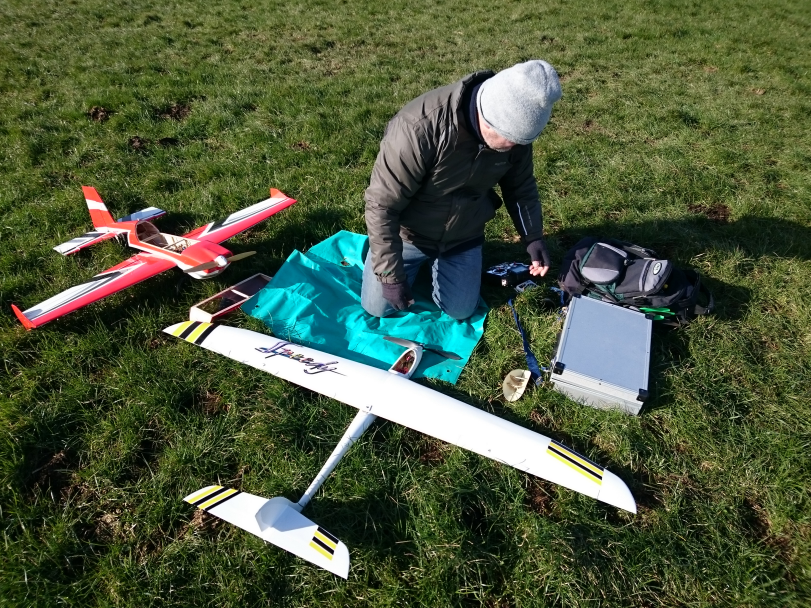 Steve first flew the model on 3 cells but wanted a bit more power so he switched to 4 cells. Unfortunately I wasn’t there to witness the event but apparently the extra power proved too much for the fibreglass fuselage and the motor ripped the nose off! I would imagine the prop was out of balance for it to do that. Steve duly completed the repairs and stiffened the inside of the nose with some ply strips.
Steve first flew the model on 3 cells but wanted a bit more power so he switched to 4 cells. Unfortunately I wasn’t there to witness the event but apparently the extra power proved too much for the fibreglass fuselage and the motor ripped the nose off! I would imagine the prop was out of balance for it to do that. Steve duly completed the repairs and stiffened the inside of the nose with some ply strips.
The motor looks like an inrunner but it’s actually an outrunner inside a case. The case means there aren’t any rotating parts to keep the wires etc away from, something that can be a problem in a glider with a slim nose. He wasn’t over keen on the kit and said it was a bit of a pig to put together but now it’s sorted I think he’s very happy with it, it certainly performs very well. I shot some video of it flying in very strong winds on 1st March but as this is the February blog you’ll just have to wait until next month to see it.
A model that has been to the field but is as yet unflown is Tony Neal’s new BAE Hawk. It’s another one from HobbyKing and is very similar to their T-45 Goshawk but in fact it’s slightly larger and uses a 70mm fan rather than 64mm.
It’s a bit odd as HK call it a Red Arrow BAE Hawk but it’s not in Red Arrows colours; in fact it has American markings! However, it looks great and I think it will fly very well, certainly the Goshawk is an excellent flier and if anything this one should be better.
Tony’s model is complete and ready to go but he wisely decided not to risk a maiden flight in the blustery winds that prevailed on the day he brought it along. Hopefully it will fly soon and I will be able to report on it in the March blog.
Gentleman Jim Hobday chose one of the calmer days to fly his Grumman Wildcat. It’s been around for a while now and is a great little flier. Jim bought it at Blackbushe a couple of years ago as a bag of foam Wildcat parts rather than a complete kit.
It seems to be the Parkzone one but I imagine it was a replacement airframe for people who had crashed theirs. So Jim had to find a suitable motor along with all the usual fixture and fittings, something he obviously got right as it flies really well.
Woody has bought himself another Pilatus PC9 to replace the one he ‘wore out’… I test flew it and discovered Woody needs a lesson on how to locate the CG! But all was well and after the addition of lots of nose weight and some elevator adjustments it flew nicely. I forgot to take a photo of the model; I just got this one of a rather dispirited looking Woody being assisted by Gentleman Jim.
I also snapped this general one of the pits on a cold and windy day.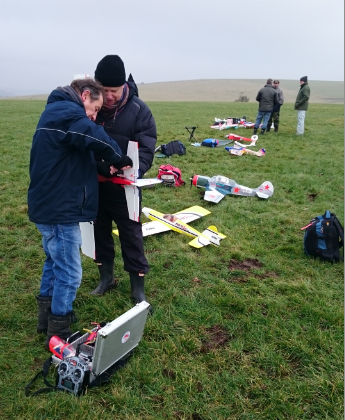
Captain Slow has discovered that his Ugly Stik has the usual ARTF undercarriage…Almost Ready To Fail. It neatly fell off on what looked like a pretty gentle landing and on closer examination it seems there was almost no glue holding the mounting plate in place.
It neatly fell off on what looked like a pretty gentle landing and on closer examination it seems there was almost no glue holding the mounting plate in place.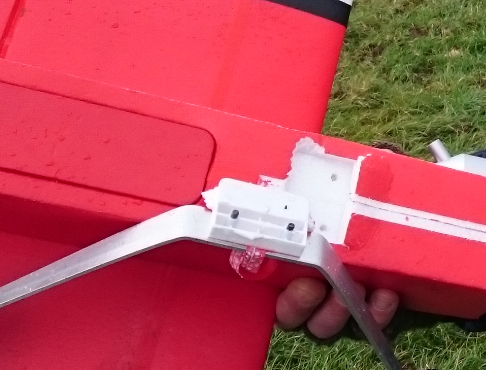
I suppose it meant it came off with minimal damage to the surrounding area but the manufacturers really need to improve undercarriage mounting for people who don’t fly from lovely tarmac runways. John has now glued it back in properly so hopefully it will stay put.
We had a very welcome surprise visit to the patch a couple of Sundays ago when a full-size Tiger Moth decided to drop in and see us! We have often seen it around the area and occasionally we have been treated to a low pass or an impromptu aerobatic display. This time he circled the field quite closely a couple of times so we landed all models to avoid him, and then he came in from the bottom corner, parallel to the road, for what we thought would be a low pass. But he touched down and stopped level with the patch and waved us over.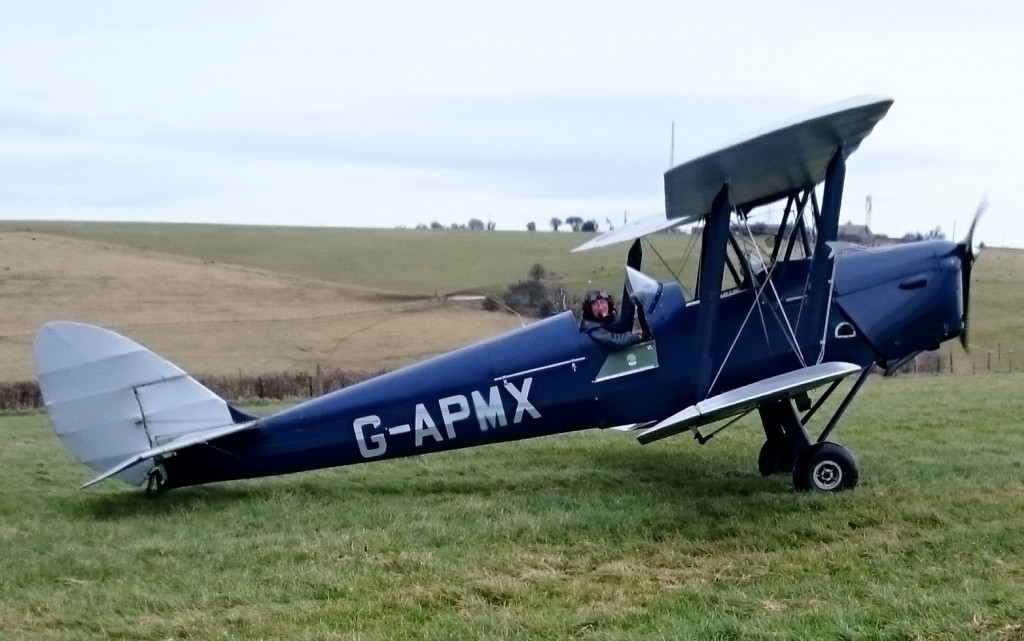
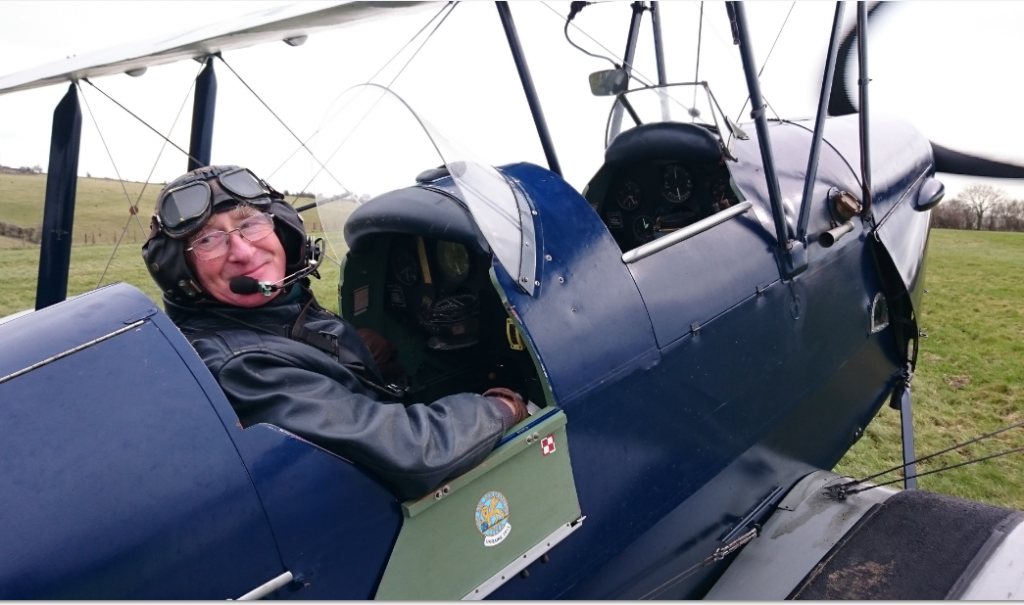 He apologised for interrupting our flying (as if we minded!) and explained that he liked seeing us fly, saying he had tried R/C modelling a few years ago but kept crashing so now he just sticks to full-size as it’s easier! He was only down for a couple of minutes, and then he taxied up to the top corner and took off again heading back towards the bottom corner.
He apologised for interrupting our flying (as if we minded!) and explained that he liked seeing us fly, saying he had tried R/C modelling a few years ago but kept crashing so now he just sticks to full-size as it’s easier! He was only down for a couple of minutes, and then he taxied up to the top corner and took off again heading back towards the bottom corner. There was a pretty strong crosswind blowing but it didn’t seem to bother him at all. Some of us took some video and photos which I have made into a short video that you can see here: Tiger Moth
There was a pretty strong crosswind blowing but it didn’t seem to bother him at all. Some of us took some video and photos which I have made into a short video that you can see here: Tiger Moth
It’s interesting so see how much the Tiger slows down when he turns into wind after take-off; it shows just how strong the wind was that day.
An Irishman arrived at JFK airport in New York and wandered about the terminal with tears streaming down his face. An airline employee asked him if he was homesick.
‘No’ replied the Irishman ‘It’s worse, I’ve lost all me luggage’
‘That’s terrible, how did it happen?’
‘The cork fell out of me bottle’
Colin Cowplain


